ENVIRONMENTAL PROTECTION COMMITTEE MINUTES – AUGUST 13, 2019
CASEY E. JORDAN, CHAIRMAN
MEMBERS PRESENT: Dr. Chase, Mrs. Tassone, 1Mrs. Abbott-Kenan
MEMBERS ABSENT: Mr. Bottrill
ALSO ATTENDING: Mrs. Ervin; see attached list
Chairman Jordan called the meeting to order at 9:00 a.m. A motion was made by Dr. Chase, seconded by Mrs. Tassone, to waive the reading of the proceedings from the previous committee. MOTION CARRIED. A motion was made by Dr. Chase, seconded by Mrs. Tassone, to approve the minutes of the previous committee meeting. MOTION CARRIED.
1. WATER ENVIRONMENT PROTECTION: Frank Mento, P.E., Commissioner; Adam Woodburn, Program Coordinator Stormwater Management
a. Authorizing the County Executive to Enter into a Contract with the United States Department of the Interior for the Operation and Maintenance of Stream Gaging Stations in the County of Onondaga
Mr. Mento:
-
Annual contract renewal; 5 gaging stations, chart, measure, and collect data on the streamflow, data is then compared with other characteristics WEP samples to compute loads that impact the lake
- Shared costs total $114,070, we pay 65%; data needed, good function, works well
Chairman Jordan said that this is part of our obligation to the ACJ so there is essentially no choice. Mr. Mento agreed.
A motion was made by Dr. Chase, seconded by Mrs. Tassone, to approve this resolution. Passed unanimously; MOTION CARRIED.
b. ACJ Update
Mr. Mento:
- 2nd Quarter Save the Rain Report pretty robust, details many highlights
1Mrs. Abbott-Kenan arrived at the meeting.
- Shows progress and activity; not many gray projects this quarter, continuing strong and forward-moving green projects
Mr. Woodburn reviewed the following:
CSO Project Update:
Progress continues to be made on several Save the Rain projects during the second quarter of 2019.
Construction of the CSO 005 reconfiguration and CSO 006 catch basin disconnection projects was completed during the second quarter. The CSO 005 project features minimally invasive and cost-effective sewer reconfiguration to connect the CSO 005 local sewer to the Harbor Brook Interceptor Sewer upstream of the existing regulator structure. By making this connection, a hydraulic choke point in the system is removed, and significant CSO reduction from CSO 005 is achieved (1 million gallons and 6 activations - as predicted by SWMM). The CSO 006 project disconnected a catch basin from the combined sewer to Harbor Brook and resulted in over 700,000 gallons of CSO reduction in cso 006.
Construction of the South Wilbur Avenue Green Street project in CSO 009 also began during the second quarter. When complete, the project will feature two infiltration trenches that capture runoff from Wilbur Avenue, just south of the Rosamond Gifford Zoo entrance, totaling 350,000 gallons annually.
The County awarded construction of the Fairfield Avenue and Hutchinson Avenue green street projects in CSO 052 to the apparent low bidder, EZ Paving. Construction mobilization began at the end of the second quarter, with full-scale construction anticipated during the third quarter. When complete, these projects will feature multiple underground infiltration trenches and a bioretention area and will capture an estimated 2.5 million gallons annually.
Construction of the following projects is planned to begin during the second and third quarters of 2019. The County will be holding community meetings and distributing flyers to the affected work areas for each of these projects prior to the start of construction.
• Berkeley Drive Road Reconstruction (CSO 060/077)
• Magnolia Street Green Street (CSO 009)
• South Wilbur Avenue Green Street (CSO 009)
• Richmond Avenue Green Street (CSO 007)
• Lakeview Avenue Green Street (CSO 006)
During the second quarter, the County progressed the design of multiple projects, including:
• South Salina Street Green Corridor (CSO 060/077)
• Elk Street Green Street (CSO 060/077)
• Robert Drive Green Street (CSO 060/077)
• Moore Avenue Green Street (CSO 060/077)
• Vincent Street Green Street (CSO 060/077)
• West Colvin Street Green Street (CSO 060/077)
• Warner Avenue Green Street (CSO 060/077)
• Washington Square Park (CSO 075)
• CSO 010 Sewer Improvement (CSO 010)
Design work for these projects is anticipated to occur during 2019 for these projects, with construction either in late 2019 or 2020. Community meetings were held for the Salina Street Green Corridor project and the additional CSO 060/077 green street projects listed above with excellent feedback received from the community.
Finally, in coordination with the City of Syracuse, the County executed a revision to the intermunicipal agreement (IMA) for the City's road reconstruction program to include GI on Wolf Street (CSO 075) and Grand Avenue (CSOs 014 and 015) during 2019. The City was planning on reconstructing both of these streets as part of their annual reconstruction program and the County will partner with the City to construct GI to capture over 3 million gallons of stormwater in advance of the road reconstruction efforts. Prior to 2019, there have been 15 road reconstruction GI projects initiated by the County in partnership with the City. These projects are extremely cost-effective for the County, allowing the County to stretch their available capital dollars further with respect to reducing CSOs.
Chairman Jordan asked Mr. Woodburn to elaborate on the green technology being used for the Fairfield and Hutchinson Avenue project. Mr. Woodburn responded that they are using tree plantings, bioswales, and underground trenches; bioswales are like a rain garden. Underground infiltration is a trench 6 to 8 feet wide and deep and a block-long where we take 1 ¼ inch of rainwater from the area so that contributing water to that trench can soak into the ground. If there aren’t infiltration rates the water is held before being released back into the sewers, which shaves the peak. After a rain event all the water gets into the combined sewers but won’t make it into the interceptor sewers so the peak flow is the issue; knocking the peak down takes all the volume and frequency out of the combined sewer overflow. Most don’t know the underground trench is even there; might see fabric bags that hold debris so that it doesn’t get into the infiltration trench. This is fairly inexpensive green technology that is much easier to maintain and one great way to get water out of the combined sewer.
Chairman Jordan said that this is more of a lower-tech natural collection than the gray collection tanks. Mr. Woodburn agreed, adding that this has more use and is smaller. Mr. Mento said that this is much less expensive. Mr. Woodburn said that the rainwater is collected before it combines so it doesn’t have all the contaminants.
Chairman Jordan questioned the lifespan. Mr. Woodburn responded that everything is oversized to help extend the lifespan; the issue is they will fill-up with fines. A 3” washed stone is installed in the stone bed and if the bags aren’t cleaned those stones could clog up and we could lose capacity. Part of the lifespan is ongoing maintenance to keep the catch basins clean, and part of it is oversizing, but we know 25-40 years down the road we may have to reinvest in infrastructure or may just need to flush them a couple of times to get them back as needed.
In answer to Dr. Chase, Mr. Mento said he would be attending the mayors meeting next week in reference to the sewers in Eastwood. Dr. Chase asked if the Eastwood area could benefit from something like this. Mr. Woodburn and Dr. Chase agreed that most of Eastwood isn’t in the combined sewer area. Mr. Woodburn said that green infrastructure could be installed but the problem there is a little more nuanced; not a straightforward problem. Dr. Chase said that it is in restrict areas of Eastwood; a huge part has nothing to do with combined sewers. Mr. Mento said that the city’s presentation will be through their consultant and he is very curious to see what they are proposing and how it may align with things WEP is doing. He is interested in how they might partner down the road and how those solutions can enhance their system and ours.
Chairman Jordan said that it would have been nice if their consultant had contacted the county for a broader picture. Mr. Mento responded that he thinks they are trying; text received over the weekend asked if he would be attending.
Mrs. Abbott-Kenan questioned neighborhood participation in reference to the recommended tree plantings. Mr. Woodburn responded that they ensure the trees will well work where they are located and try to design the soil so that it works for the trees planted. They also, install Silva Cell - essentially a Lego block system 2 feet x 1 ½ feet x 1 ½ feet, stacked 2 to 3 feet high under the sidewalk, fill in with soil, plant tree, and the concrete sidewalk can go on top. Runoff from the street is sent into that system; water has a place to go, trees have soil to grow in, get bigger and live longer. This technology was used in the Connective Corridor, on Water and Montgomery Streets and trees planted using this system have proven to grow better. The city arborist is also looped in and has been very helpful.
Chairman Jordan asked how they determine which projects to do and the order; previously some projects were chosen that did not have a great return on investment. Mr. Woodburn said that they use a stormwater model (SWMM) to understand their pipe and conveyance system. Green technologies are plugged into the model to try and understand how it impacts the combined sewer overflow, then decisions are based on the benefit of gallons captured at the project site and the CSO; sometimes there is a disconnect based on distance. Some of these projects may be mothballed; had sewer break at Colvin and Midland, repaired 15” regulator pipe with 24” pipe, may make these projects are no longer necessary. Mr. Mento said that this was a huge find and benefit, as a result of installing the 24” regulator they are saving millions of gallons of runoff from going into Onondaga Creek. Mr. Woodburn said that CSO 060/077 is a very active overflow, 29 times a year, 7.1 million gallons, and this repair may take it down to zero. Mr. Mento said that a simple change like this came about as a result of running the model to see the upsizing impact to the CSO, rather than just fixing the pipe, and it was astronomical.
Mrs. Abbott-Kenan said that it seems like a no-brainer to make it bigger, even if you know nothing about this, but questioned the cost. Mr. Mento responded that it was about $88,000 for the emergency repair and another $50,000 to $75,000 to change out the regulator; relatively minor in terms of dollars for the benefit. They would have to do a multimillion-dollar project to get the same kind of relief.
Dr. Chase asked if they know who many inappropriate intersections of pipes there are that could be fixed before becoming an emergency. Mr. Mento responded that he wished he did. Mr. Woodburn said that CSO 005 was one, CSO 010 is a project they are working on, and CSO 011 is the Fowler project. A couple of years ago they pushed the SWMM model to find pinch points and pipe size issues. It is not once and done; always push to find projects that are great wins, still some unknowns. They cannot get into every piece of pipe owned without putting people’s lives at risk just for investigation and construction is really, really difficult; sitting on a couple of projects, i.e. 2 large pipes on the Creek Walk under 690, CSO 020 and 021. Regulators are under 690, to reach them have to go down 20 feet, then over 60 feet, and then down another 20 feet; waiting and hoping DOT will get it so that we can fix those issues when we get there.
In answer to Chairman Jordan, Mr. Woodburn confirmed that projects with the biggest bang for the buck are selected and completed by going down the list. Under the legislation tab, there is an IMA with the city for road recon and green infrastructure is installed where capture is needed. It is the most cost-effective way to reduce CSO overflow. Gray projects can be very expensive, even if it is a pipe configuration project, i.e. Midland/Colvin intersection, the bottom of Colvin pipe is 14 feet down and the bottom of the Midland pipe is 21 feet down. Construction is very difficult and has the ability to blow up very quickly but sometimes it is the most cost-effective solution.
Chairman Jordan questioned the amount of dialogue between WEP and the city on work projects so that either could do work while projects are open. He then detailed an example from the Clinton Street project in which newly installed asphalt had to be dug up by the city to replace a water line. Mr. Woodburn responded that there are bi-monthly meetings with the city. Engineering, DPW, water, sewer, and parks are all at the table and we walk through everything we are doing and what we are planning further out. Coordination is really great in some instances. The county has an IMA with the city to replace unearthed lead water pipes and the city does the other half of it because they can go into the house. Also, have very similar conversations with National Grid who is mandated to replace all cast-iron mains; try to coordinate with their construction list and sometimes push them to be at road recon projects, work hard to make everyone aware when we are doing a project and what is going on.
Chairman Jordan said that there have been some projects where the city does work that we would be doing because they are already in there, which is great. Mr. Mento said that he thinks the partnership and communication are getting a lot better. Dr. Chase responded that it is. Mr. Mento said that road work is one component of this, city parks is another. Mrs. Abbott-Kenan asked who picks up the costs. Mr. Mento said that it depends on the project, i.e. for the Meachem project we agreed to provide our pipe to city contractor who will dig the trench and install it. Mr. Woodburn detailed another example where the opposite was done for the city with water pipes. Chairman Jordan said that this was good to hear.
Mr. Woodburn continued:
-
Opened up the Green Improvement Fund in the 2nd quarter, held 1 meeting, had a couple of resubmissions; notable Near Westside Performance Park, to be located near WCNY building, great park project and helps with combined sewer overflows
-
Ambient monitoring and Facebook page information is detailed in the report; continue to get our message out
-
Also includes Cornell Cooperative Extension contract to help with public awareness and environmental stewardship for water conservation, urban forestry, and pollution prevention
Mr. Mento said that the Save the Rain and Connect the Drops initiatives continue to be very important. However, as we go forward and bring down the ACJ a little, Save the Rain will focus more on maintenance, which is an important piece of green. There will still be Save the Rain projects but the focus will be on good maintenance so that we continue to get the capture that has been programmed into the model. In answer to Mrs. Abbott-Kenan, Mr. Mento defined maintenance as clearing out weeds, making sure medians, rain gardens, and bioswales are free from clogs and impediments. General maintenance seems subtle but is important because it is programmed into the model. Chairman Jordan said that maintenance helps extend the useful life. Mr. Woodburn said that one of the push backs has been that nature in the city design looks a little unkempt at times; try hard to make it look aesthetically pleasing outside City Hall.
Chairman Jordan said that one goal was to get out from under the yolk of the agreed ACJ while continuing our maintenance, and questioned where this was at. Mr. Mento responded that they are negotiating with ASLF and will move into a state order at some point in the very near future. ASLF will be out of the picture and the order will be between us and the DEC, which begins the process of winding down the ACJ to a level where we can apply for a variance and be done with it. Long story short, we are working on strategies to move into the next phase of the ACJ called a Long Term Control Plan (LTCP); a less expensive but required phase. This is very complex.
Chairman Jordan asked if there was any idea when they would be free and clear of this. Mr. Mento responded that it is a very difficult question; will have better answers in the very near future. Chairman Jordan said that they keep extending and adding new requirements to the agreement. Mr. Mento agreed and said that this was the reason it was important to get ASLF to settle with us. Then it is just us and DEC and they recognize the good work we have done and how far we have come.
In answer to Mrs. Abbott- Kenan, Mr. Woodburn said that Mike Bristol and Digital Hyve produced the Save the Rain digital communications. Mrs. Abbott-Kenan said that they did an extremely effective job this year.
Chairman Jordan asked for a motion to adjourn. Dr. Chase asked to talk about the meetings for Loop the Lake and such:
-
Meetings are a sham, nobody comes, aren’t held in appropriate places
-
Before the snow flies, this committee should recommend that a meeting be held in the park with the people that actually use the park to get their opinion as to what should be done
-
The last meeting had at least 10 county employees, 10 running for office, and maybe 10 cared about what was going on; those asking questions were told to go to the tables because they don’t answer questions
In answer to Chairman Jordan, Dr. Chase said she was referring to Loop and Lake and the beach. Chairman Jordan said that this was not for Environment Protection, it would be more for County Facilities. Dr. Chase that it was both. The big issues for people not wanting these things revolve around the environment, and she feels that they aren’t giving constituents appropriate service by not asking those already using the park what they want.
Mrs. Abbott-Kenan said that it is always a challenge to get people to these type of meetings; surveys have been done and data shows people want the beach. Dr. Chase said that there this data showing 65% don’t. Mrs. Abbott-Kenan said that it is a challenge to find reliable data but on behalf of the county she does not think it should be only those using the park now. The idea would be to make it accessible to those who have never gone there as well. Dr. Chase said that we need to listen to those using it now and hopefully they will be the communication to those that aren’t using it. Soon we will be asked to spend millions doing this and it would be nice to know that more than 30 people had input.
Chairman Jordan said that we can talk more about this but people cannot be forced to come to a meeting. Dr. Chase agreed. Chairman Jordan said that usually what he sees is half of those with a vested interest come, which can be completely unrepresentative of how the bulk of the population really feels. If you only have one aspect of one side coming or talking loudly about it, you are really not getting an accurate picture. Dr. Chase said that she feels strongly about it because her Northside refugee constituents don’t’ have an opportunity go to Green Lakes but could walk to this beach if it is built. It is a really good idea but it is expensive, and she would like to know that people are going to use it and think it is a good idea.
Mrs. Abbott-Kenan said that she thought data points showed this. Mr. Woodburn said that Ken Danter, a sub-consultant of Barton and Loguidice, did the study, both with the survey and the data to understand it, and his part of the presentation drove home that there is a user group if you build it, and he had a lot of data points behind that. Mr. Danter has been doing surveys and crunching numbers for recreation stuff for about 50 years – he is literally the guy you go to. Mrs. Abbott-Kenan said that we have to trust in that; if we don’t that is another conversation. Dr. Chase said that she was a researcher and hates just people surveys. Chairman Jordan said that they could talk about this further.
Chairman Jordan adjourned the meeting at 9:46 a.m.
Respectfully submitted,

KATHERINE M. FRENCH, Deputy Clerk
Onondaga County Legislature
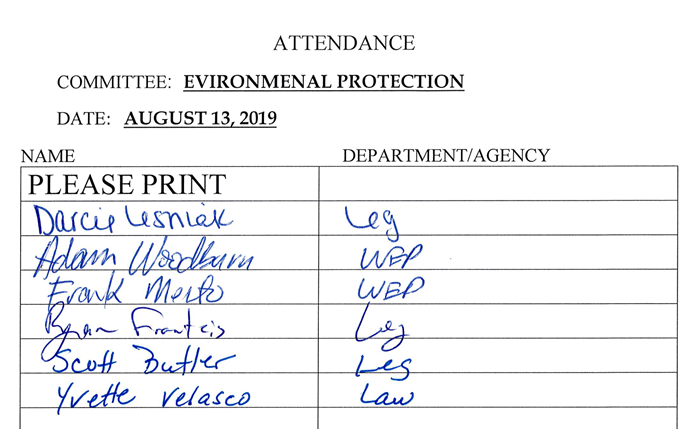
* * *
COUNTY FACILITIES COMMITTEE MINUTES – AUGUST 13, 2019
JUDITH A. TASSONE, CHAIR
MEMBERS PRESENT: Ms. Cody, Mr. Holmquist, Mr. McBride, Mrs. Ervin
ALSO ATTENDING: See attached list
Chair Tassone called the meeting to order at 10:32 a.m. A motion was made by Mrs. Ervin, seconded by Mr. McBride to waive the reading of the minutes of the previous committee meeting. Passed unanimously; MOTION CARRIED. A motion was made by Mr. McBride, seconded by Mrs. Ervin to approve the minutes of the previous committee meeting. Passed unanimously; MOTION CARRIED.
1. TRANSPORTATION: Marty Voss, Commissioner
a. Amending the 2019 Onondaga County Budget to Accept $759,195 in Extreme Winter Recovery Funding from the New York State Department of Transportation, and Authorizing the Execution of Agreements ($759,195)
Mr. Voss handed out the following:


- EWR allocation of $759,195 - above is the list of additional roads to be treated this year
- Already started working on a couple roads - trusted the Legislature would support this and pass money from state
- Limited construction window, so hustle to get everything out to bid, awarded and started
A motion was made by Ms. Cody, seconded by Mr. McBride, to approve this item. Passed unanimously; MOTION CARRIED.
b. Authorizing Execution of Agreements for the Acceptance of a Permanent Easement Across Property Owned by Honeywell International Inc. Located Along the Western Shore of Onondaga Lake
- Accepting permanent easement for Phase II from West Side Pump Station to Harbor Brook
-
Being built by Honeywell (~7,100 ft); easement for duration of trail extension; will be part of Loop the Lake, which will then be part of the Empire State Trail - authorizing County Executive to sign contracts to accept easement
Mr. Rauber responded to Chair Tassone that Honeywell should have this done this year. They still have cleanup and capping to do.
Mr. Voss continued:
-
In Phase I - pushing towards completion this fall; Phase II is next piece from Harbor Brook to Hiawatha; going through planning and approval process with CSX, NYS DOT, FHWA, etc.; engineering and legal intensive process
-
Mr. Voss said Mr. Rauber is doing an outstanding job staying on top of it
- Gives trail users connection from Honeywell Visitors Center to Harbor Brook; very scenic part of trail with views of lake
A motion was made by Mrs. Ervin, seconded by Ms. Cody, to approve this item. Passed unanimously; MOTION CARRIED.
c. Authorizing the Execution of an Empire State Trail Work and Maintenance Agreement Between the New York State Office of Parks, Recreation, and Historic Preservation (“NYSOPRHP”), New York State Department Transportation (“NYSDOT”), and Onondaga County (“COUNTY”) for Trail Crossings on two County Roads
- NYS building pieces of Empire State Trail to link to Loop the Lake; statewide recreation and venue for everyone
-
Pieces connected in Camillus from Erie Canal Trail - State will improve Warners Road and Gerelock Road
-
NYSDOT is going to construct the trail components and install crossings at those roads – County is agreeing to maintain those crossings for 10 years (includes striping and well lit yellow signage); County’s jurisdiction
-
Does not require work on trail, just striping roads when crossings are worn out; part of normal maintenance
- Nominal expense that is baked into operating; will be out with paint truck doing striping anyway
A motion was made by Mr. McBride, seconded by Ms. Cody, to approve this item. Passed unanimously; MOTION CARRIED.
Mr. Voss told Mr. Holmquist that the Fremont Road Bridge project will be done this year.
2. PARKS AND RECREATION: William Lansley, Commissioner
a. Accepting Donation from Friends of the Rosamond Gifford Zoo, and Amending the 2019 County Budget ($30,000)
- Accepting $30,000 from Friends of the Zoo in support of boardwalk through elephant exhibit
- Enhanced operation for safety of staff; hydraulics for gates open remotely using separate remote at site
- Upgraded to hand held remote to open and close gates at any position; safe for elephant keepers with large property
-
Donation covers additional cost of this project
-
2 gates located under the walk over - visitors can walk down concrete stairway and cross over a tunnel that the elephants walk under
-
2 manual gates that cross trail (debut that this week) - get to walking trail and gates open; closest visitors get to elephants where they walk from yard to yard
-
1 gate that opens from existing yard to new yard
-
Big expansion with a couple acres; well received; ripped down boardwalk to get down to grade level, so maintenance is easier and no failing elevated infrastructure
Mr. Lansley mentioned taking the committee for a tour, and Chair Tassone said possibly in the fall.
A motion was made by Mrs. Ervin, seconded by Ms. Cody, to approve this item. Passed unanimously; MOTION CARRIED.
The meeting was adjourned at 10:43 a.m.
Respectfully submitted,

JAMIE McNAMARA, Assistant Clerk
Onondaga County Legislature
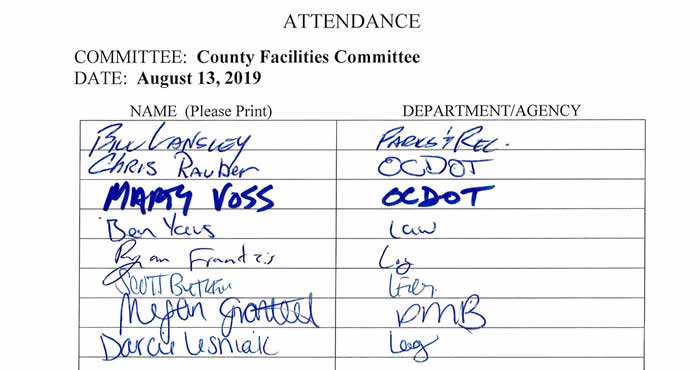
* * *
PUBLIC SAFETY COMMITTEE MINUTES – AUGUST 13, 2019
CHRISTOPHER J. RYAN, CHAIRMAN
MEMBERS PRESENT: Mr. Bush, Mr. McBride, Mr. Rowley, Mr. Bottrill
ALSO ATTENDING: Chairman Knapp, Mrs. Abbott-Kenan, Mrs. Ervin, Mr. May; see attached list
Chairman Ryan called the meeting to order at 12:04 p.m. A motion was made by Mr. McBride, seconded by Mr. Rowley, to waive the reading of the proceedings from the previous committee. MOTION CARRIED. A motion was made by Mr. Bottrill, seconded by Mr. McBride, to approve the minutes of the previous committee. MOTION CARRIED.
Chairman Ryan stated that the agenda would be taken out of order.
3. Memorializing New York State Department of Corrections and Community Supervision and Division of Parole to Enact Specific Communication Protocol that Alerts the Public to Absconding Violent Offender Parolees in the Interest of Public Safety (Sponsored by Mrs. Abbott-Kenan)
Mrs. Abbott-Kenan:
-
Wants to send a communication to NYS Parole Board and DOCCS asking for specific communication protocol when violet parolee absconder’s put the public at risk; doesn’t profess to be in law enforcement, however, believes there is due diligence when trying to locate somebody in alerting the public to avoid anyone being in harm’s way
-
End of July Christopher Block, a convicted kidnapper and sexual abuser on parole since Dec. 2018 cut off his ankle bracelet on Prentiss Drive in Skaneateles; the state agency was the lead, took 2 hours for reverse 911 call to go out, successful in alerting exactly 55 residents
-
A host of friends called asking what was going on - had 20 girls at a sleepover bouncing on a trampoline and bomb fires, a helicopter was flying over; she lives a street over and was not alerted, backyards on West Lake Street butt up against Prentiss Drive and were not in the call area
-
Not up to her to determine how but would like specific parameters and guideline for alerting the public; undetected for 35 hours, no public notification or acknowledgment from DOCCS or the NYS Parole Board for over a day and a half, found off of 41A at Skaneateles Golf Course Country Club
-
Over 200 children were at the country club day camp; general manager called her to find out what was going on, could not even get confirmation that there was still a search or otherwise
-
A women’s golf tournament was also being held there and the recidivism rate is huge for parolee’s like him; effects all our shareholder
-
Wholly unacceptable in the interest of public safety; wrote to DOCCS, completed due diligence, asked for letter confirmation receipt, still not received
-
Proud of the DEC guys who found him; this will happen again, people were in harm’s way, dodged a major bullet, let's learn from this and determine what we can do better so that nobody gets hurt in the future
Mr. Bottrill questioned if they know why the Sheriff’s office or local law enforcement were not informed. Mr. Gonzalez responded that he did not know about all local law enforcement but he does know that Sheriff Conway was not notified by DOCCS until long after the event, and he does not know why or what the process is for notifying. Mrs. Abbott-Kenan stated that she and the Sheriff talked a couple of times about this; when they called they called the Sheriff and Skaneateles Village Police. According to Sheriff Conway, they only know what they tell them and regardless of how the call went out, it was one of our lieutenants who suggested it because DOCCS or the Parole Board hadn’t done anything. She understands that in the midst of stuff they are probably crazy but there is an onus on public safety that she is concerned about and that is their responsibility as the lead agency. She is very glad the lieutenant decided to pull the trigger. We are all humans and, however this got dropped, she would just like an answer.
Mr. McBride asked what the protocol would be. Mrs. Abbott-Kenan responded that it is not her job to decide protocol – it is for them to decide; she is representing humans, is not trying to tell anyone what to do, and is not in law enforcement. An example of something that would make sense to her is determining steps, i.e. school safety: Step 1 - locks, Step 2 – lights, Step 3 – out of sight. A lot of this is a judgment call and protocol provides a checklist for people. This was a huge misstep, and she is thrilled that no one got hurt. The Cayuga County Sheriff alerted hundreds of people and there wasn’t one complaint about erroring on the side of caution.
As a follow-up, Mr. McBride said that this is the second ankle bracelet that was removed and one would think we could have some kind of device that doesn’t get cut off. Mrs. Abbott-Kenan said that in the melee of having to deal with a crisis situation you just cannot forget the safety of average innocent humans living in that area and she would like that to be considered. For whatever reason, they do not feel an onus to communicate. She understands they don’t want to jeopardize their investigation, nobody wants that, but that is not a good answer.
Mr. Bottrill questioned if violent offenders was too specific or something that the agencies would use as a whole other list. Mrs. Abbott-Kenan said that she spoke with Ms. Velasco and others, and violent offender seems to satisfy her intentions. Mr. Frateschi said that a violent offender is a specific classification. Chairman Ryan asked if the law classification encompassed sexual offenders as well. Mr. Frateschi responded that he did not know. Ms. Velasco’s answer was inaudible.
Chairman Ryan said that it is important to make sure that this encompasses everything we want it to do; error on the side of caution and cast a wide net, so that if any offender is fleeing we know about it. Part of this is that we are learning as we go; it is not ok that the Sheriff’s Department was kept in the dark, it is truly unacceptable. Having as many people know about it, in a timely fashion, in the interest of public safety, is paramount.
Chairman Knapp said that a lot of lessons have been learned from this, and we can do better. One thing we haven’t talked about, but need to work on, is the fact that many folks no longer have landlines, and the landlines are what are tied to 911. In answer to Chairman Knapp, Mrs. Abbott-Kenan confirmed that cell phone numbers can be added by going to the Emergency Communications website at
https://signup.hyper-reach.com/hyper_reach/sign_up_page_2/?id=56612
Mrs. Abbott-Kenan said that initially they tried to reach 78 people, but only 55 had landlines. Chairman Knapp said that as a community we need to spread the word that unless your cellphone is added on it is probably not part of the 911 system and you will not receive the notification, also those with landlines can add their cellphone number so that they are notified when they are not home.
Chairman Ryan said that communication is the key. There should be a conversation with Emergency Management and Emergency Communications; doesn’t think anyone wants to get into they did this or that. However, there is a learning opportunity for whatever happened here; a lot more people should have been notified and we have an opportunity to see that this shouldn’t happen again.
Mr. Bush asked what the protocol is. Mrs. Abbott-Kenan said that she cannot get an answer and doesn’t believe there is any. Mr. Bush stated that this is where you would start to understand the problem. Ms. Rooney said that 911 protocol is that the requester of the reverse 911 call must provide the exact geographic location for where they want it sent. For clarification, no one at 911 makes that decision, the law enforcement on-site making the request has to give the exact parameters. Those were the only parameters requested and 911 never overrides that request. Chairman Ryan said that there is also the possibility that they knew more than we thought they did and it was very targeted.
In response to Mrs. Abbott-Kenan, Chairman Ryan said that maybe we should know actually where they were, who they notified and when, and how it was done, which may provide answers to some of these questions. Mrs. Abbott-Kenan responded that she has requested the information. According to Sheriff Conway, a lieutenant made a judgment call for the reverse 911 call, and thank goodness he did because the lead agency did not. In answer to Chairman Ryan, Ms. Rooney confirmed that a Sheriff on scene made the reverse 911 request; no one from NYS Parole or DOCCS did.
In answer to Mr. Bottrill, Chairman Ryan said he was thinking of holding this until some of these things were answered. Mrs. Abbott-Kenan questioned who he was going to get answers from; she has sent letters, followed up, asked for return confirmation receipts, and has not received a response. Mr. Bottrill said that this is important; if something like this is put into effect it would be helpful countywide. This is a big-picture we should have and there are benefits for the community at large; get some answers but should strongly consider moving forward. Mrs. Abbott-Kenan said she is concerned about waiting any longer. A host happened at the end of July and there was no answer to any of the media, municipalities or herself – would love to know the avenue for getting the answers. Mr. Bush asked if it was possible that the procedure was already in place but wasn’t implemented through human error or judgment. Mrs. Abbott-Kenan responded that after talking to local law enforcement she does not believe there is a protocol for notifying the public.
Mr. Rowley said that this is just one more arrow we can use to try and get the state’s attention saying we want some answers in terms of the protocol so that this doesn’t happen in our community again. Relative to the resolution, we could try to find out some more things but this item has been considered and can go to session. Chairman Knapp said there are still some moving parts and suggested not taking a vote; it has been considered.
Chairman Ryan said that there may be an opportunity to add additional teeth to the resolution; maybe add the Onondaga County Legislature calls on all authorized agencies to develop a strict protocol so that this doesn’t happen again. To Ms. Rooney’s point, there was no failure on the part of Emergency Communications but we could call on Emergency Management, Emergency Communications, and the Sheriff’s Department to work with any and all authorized agencies to ensure we get a clear and concise protocol to begin going forward. In the event that this happens again we are at least starting the ball rolling so that we aren’t having a conversation trying to dissect how it went wrong, we are talking about what went wrong and how to fix it. Wording can always be added in and voted on at session; doesn’t like to kick the can down the road. This is an important issue on everyone’s mind.
Mrs. Abbott-Kenan said that she tried to avoid finger-pointing in wording the resolution but that is what happened right off the bat. In fact, the Cayuga County Sheriff issued an apology saying they are going to work better and she doesn’t know how we are going to do that; lines are drawn within agencies so she is concerned. She knows her lane and was cognizant of finger-pointing; clearly needs to be better communication collaboration between agencies, felt it was not for her to say. Mr. Rowley said that he thinks Mrs. Abbott-Kenan is on the right track. Between now and session if there are ways to make it better he would encourage her to do so but he would like to vote on this at session.
Chairman Ryan asked what an additional resolved clause might look like. Mr. Frateschi responded that the feedback from the committee indicates the issue is whether there is a protocol. This resolution requests that the protocol be shared if it exists and that one is put in place if it does not. It is up to this committee if they want to add to more to that issue. Mr. Bush said that maybe between now and session there will be a response. Mrs. Abbott-Kenan responded that there are several foil requests from all the media.
Mr. Bush thanked Mrs. Abbott-Kenan for bringing this forward. Mrs. Abbott-Kenan responded that she doesn’t want anyone to get hurt.
2. SHERIFF: Chief Ken Andrews, Civil Department; Chief Esteban Gonzalez, Custody Department
a. Informational Update
Chief Andrews presented the following and stated that the first page is the basic projection; the following pages are the same but explain where the overtime is and so forth.
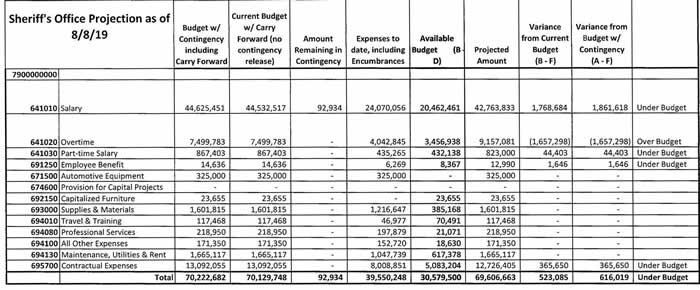
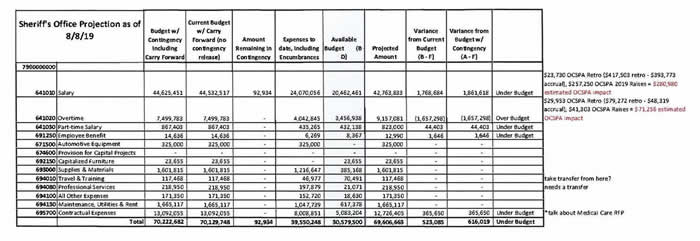

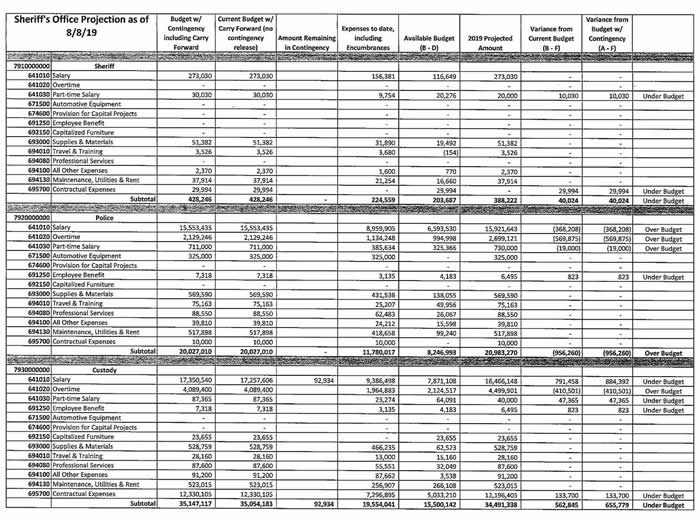
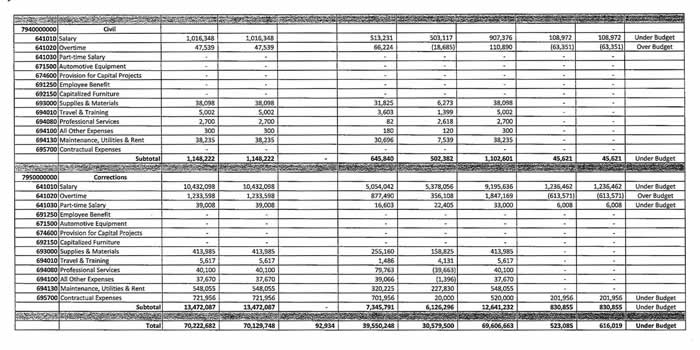
-
Pretty positive, currently $600,000 under budget,12 correction officers scheduled to start 9/9/19, will hit the 101 line but not anywhere near as much as the under-budget amount
-
2nd graph shows OCSAP impact(see pg. 4), $280,000 increase due to contract settlement, still under budget by $1.8 million
-
Professional staffing of the Sheriff’s Department is difficult at best, overtime used to maintain patrols and staffing in the Justice Center and Corrections; many more than 12 Corrections openings currently at Jamesville
-
Cayuga County allowed them to add 12 people to their academy; went through 140 names, only 12 candidates were eligible to go through the process
Mr. Bush said that they may lose some of the 12. Chief Andrews responded absolutely; these are the ones that have gone through the background check, polygraph, and everything else. We usually lose some through the psychical training or defensive tactics aspects or things like that so we may not get 12 to graduate but are hopefully sending 12 on September 9th. In answer to Mr. Bush, Chief Andrews confirmed that all 12 from the Cayuga County Academy are committed to Onondaga County. Onondaga County is currently running an academy but is still short-staffed; 21 candidates currently in the academy are taking a police officer position but aren’t filling any shifts. Overtime is high because when we hire it doesn’t give us any relief for 9 months to a year in the case of police. We are doing the best we can; each time we’ve had double filled positions it is usually one position by the time they get out of the academy because someone retires or doesn’t make it through.
- Other graphs are just different departments and the division breakdown between Custody, Corrections, and Police
- Police are difficult, over budget in salary, overtime, and part-time; will continue until people are out of the academy
-
Overall doing pretty good, confident they will come in under budget again this year
-
3rd graph (see pg. 4) points out how much the Centralized Arraignment Court (CAC) costs – an unfunded mandate absorbed by the department
-
Districts asked for additional school resource officers after the 2019 budget was complete, Sheriff distributed 4 additional officers, moved officers from filled Police positions, caused additional overtime
Mr. Bush thanked Chief Andrews for supporting Baldwinsville’s request. Chief Andrew’s responded that the sheriff feels very strongly that this is where he should deploy officers although it took away from some patrol positions that also needed to be filled, and those are filled with overtime.
In answer to Mr. Bottrill, Chief Andrews said that a GIVE grant allowed them to patrol within the city. Units would be assigned to certain high-crime areas and a group of deputies would serve there. Mr. Bottrill asked if this was still ongoing as areas near his and Chairman Ryan’s district might need some help. Chief Andrews responded that the GIVE grant has been renewed yearly; patrols are rotated as to where and how they work. Mr. Bottrill said that he was thinking of lower Avery Avenue and Charles Avenue and asked the process for neighborhoods needing assistance. Chief Andrews responded that he would suggest talking to Sheriff Conway or Undersheriff Cassalia. Mr. Bottrill said that this is something he would like Chairman Ryan to consider particularly for areas of their districts. Chairman Ryan responded absolutely, particularly in the city and where the west end meets the east end of Solvay. If there is an opportunity for multiple agencies to deploy resources and work together it will be beneficial for everyone. Chief Andrews said that he will have Chief Ciciarelli and the Undersheriff bring Chairman Ryan up to speed on the deployment of patrols.
In answer to Mr. Rowley, Chief Andrews confirmed that $280,000 of the over-budget Police salary was due to the OCSPA settlement. Mr. Rowley said that Chief Andrews had mentioned double filling and he wanted to make sure that wasn’t the case; monthly reports are provided for double filling and he hasn’t seen one for Sheriffs. Chairman Knapp stated that at the time that contract was approved the CFO said the standard policy has been that they take that number, $280,000, put it against their budget and see how we make out; yearend transfers are made if needed. Mr. Rowley responded that he understands we don’t necessarily budget for raises.
Mrs. Ervin stated that she hoped Sheriff Conway would be present. In reference to recruiting and not being able to find enough people, she does not understand why she keeps getting the same answer over and over again when there are people who say they have tried to get into the Sheriff’s Department and can’t – what is the problem that they cannot get people to work for us. Chief Andrews responded that policies and procedures are set up through the recruiting process. People go through background checks, polygraphs and have to meet a certain standard. This has been changing, i.e. marijuana usage. Formerly, if you ever used marijuana you could not be a police officer, then it changed to if you hadn’t used in the last 5 years and now you are eligible if you haven’t used marijuana in the last two years. Police officers aren’t as hard to recruit as corrections and custody deputies. When the economy is bad they don’t have a hard time because they are jobs that people can get but it is not a sexy and glamorous job.
Mrs. Ervin stated that from the first time Sheriff Conway took office he said he would recruit differently and bring diversity on the force. He has not done that and she wants to know when that will happen. She should have answers and shouldn’t have to ask this question every year. It makes no sense that we cannot come up with something different to get people on the force and have people that look like her get a job. She then asked that they take this message back to Sheriff Conway, ask him the same questions again, and ask him to give her an answer. Chief Gonzalez responded that the Sheriff sends his regrets and asked that he attend in his absence. We changed our recruiting and spread a wider net; perhaps it is not wide enough, as evidenced by some areas not getting as much diversity. However, the last combined Corrections/Custody class was very, very diverse. There were many people from many different cultures and ethnicities. He suggests capturing that magic in a bottle for whatever was done in that model and overlaying it over the entire process. We expanded resources and attempted to do everything we could; spent a lot of money on recruitment, videos, and putting things on the internet. Some times to great success and other times to no avail and we don’t know the answer; study our history and try to determine if it is the economy or that people don’t want to work in law enforcement because there is a stigma. People are held to a standard, which has changed with the times, but if they don’t come in we don’t close the door forever. They can come back once those who have used drugs have been clean for a while or those with criminal conduct can come back once their history is a little cleaner. It is a continually revolving door but it is not that we are not trying. The resources have yielded some results but not enough, and he agrees there needs to be more.
Chairman Ryan said that he doesn’t know that there is magic in a bottle. He is sure they are doing everything they can to recruit a more reflective workforce, and whatever we can do to help facilitate that we will, but he doesn’t know how we get there. DOCCS mandates minimum staffing standards and if we don’t meet those minimums we are out of compliance and that is not a place we want to be; gets the sense that we are close to hitting the panic button. We have been talking about this for a couple of years and have gone way outside of Central New York to try and recruit. Chief Andrews responded that they are also controlled by the civil service system, therefore, people have to take the test. With Corrections and Custody, the last class was more diversified because we could go through the entire list. With Police, the list is bigger and perpetual. We can only take the top three scores so sometimes we don’t get below the 90’s. We cannot canvass everyone because we cannot hire them because of civil service requirements; that lends itself as to who gets recruited into the process.
Mrs. Ervin said that sometimes we hide behind the civil service process because there are ways to help people pass the exams but we don’t try to help them. We need to start thinking about how we can get people in rather than keeping them out. Her whole point to all of this is to find a way to work with whatever agencies or places they can go to in this county to help folks; has been told there are tricks to passing the exam. Let’s find a way to help people and go beyond saying we cannot find folks. Chief Gonzalez responded that he likes Mrs. Ervin’s idea and knows that OCC offers courses, theoretically, on how to elevate your civil service score. He suggests, based off of that, doing a pre-judge for those type of courses and then waving the fee; evens the playing field, everyone has the same education, and there is no socioeconomic factor involved in taking the exam. Mrs. Ervin responded, “Let’s do something.” Chairman Ryan asked how we would ensure that everybody knows about it. Chief Gonzalez responded that it is part of recruiting; have to cast a wide enough net to ensure that where we are advertising is hitting the population. Chief Andrews stated that we would have to know when the course is offered and advertise 3 to 6 months before, and know when the next Police exam is being given so that the course ends weeks before the exam.
Chairman Ryan said that 12 officers are coming on but they are already short-staffed. Chief Andrews responded that we are currently down 20 in the Corrections Department. Chief Gonzalez stated that this just stops the bleeding. Chairman Ryan noted that 2 to 4 could retire in that time. Chief Andrews responded that there will be another test in the fall and we will probably have another Correction/Custody academy by March 2020; unsure if there will be a Police academy.
Chairman Ryan said that, if and when we work on getting the word out, can we ensure that this committee, OCC, and the Sheriff’s Department work together to recruit anybody and everybody and make sure that all understand that we think there are ways to help them get through this test; use social media or whatever. These are strategies that we are not used to doing because everything changes. Chief Andrews responded that we have a public information officer who handles community relations and we can work with the committee on that. Mr. May said that social media is kind of a new thing that the Sheriff has been using to recruit and he thinks it is important.
Chairman Ryan said that the 101 line is down but the overtime is up; cannot have both, are under budget, which is a good thing. Mr. Bush responded that the budget figures are interesting, and asked for a list of staffing; how many in each department, what is the need or goal. Chief Andrews responded that staffing numbers are reviewed on a monthly basis. Off the top of his head, there are 800+ employees throughout the Sheriff’s Department including Corrections. Mr. Bush said that he did not need a rundown now but it was important for him to know how short-staffed they are numerically; doesn’t know how many Sheriffs are in the county or the number patrolling.
Chairman Ryan said that they are definitely short on the road patrol but Mr. Bush is making a good point, are we getting short-staffed to the point where shifts at Jamesville or the Justice Center are running the bare minimum. Chief Gonzalez responded that the NYS Commission of Corrections is the regulatory body, not DOCCS, which regulates the staffing of all jails in NYS. The last officially accepted staffing analysis done by the commission was completed in 2002; supposed to be done every 10 years, requested analysis in 2012, finally got them to come out after several years, did a draft audit and draft report, still waiting on the official staffing analysis. The last time he called they said now that Corrections and Custody Departments are all under the Sheriff’s office they are going to come back and do a combined audit; some initial information gathering has been done, don’t know if they will follow up with more onsite visits. Mr. Bush said that he understands the recruiting problems but doesn’t want a financial problem; wants funds available if they can get recruits to fill the roster. Chief Gonzalez responded that we want that too. In answer to Chairman Ryan’s previous question, we run short-staffed but this also has to do with medical restrictions that are allowed in the Justice Center, which Jamesville does not have. Currently, we are in negotiations with the union; medical restrictions allow staff not to work when ordered, ties our hands and causes us to be below the required staffing level.
Mr. May said that he understands they are waiting on the state but a lot has happened in that time span, even over the past year, i.e. Raise the Age (RTA), no cash bail. Questioned how they factor in those dynamics and provide an educated guess or is it a moving target where they need to take the data provided by the state, the reality of what they are dealing with as a result of these changes, and how they are doing business to come up with a number; what is the plan. Chief Gonzalez responded that we aren’t waiting for what-ifs and are in constant dialogue with the Commission of Corrections. The reality in front of us is that the bodies we now have, plus the 14 vacancies at the Justice Center are deployed 24/7 to the best of our ability. As Chief Andrews mentioned CAC is a mandate; 7 bodies that include the relief factor have been taken out of rotation, already had 14 vacancies, adding this takes them to 21 and there is only so much water in the well. When it comes to mandated staffing, activities, and issues at the Justice Center sometimes they have to shut down posts of the Justice Center based on safety; can’t let inmate and staff lives be in jeopardy. There are only so many bodies and they are allowed to use their medicals to get out work, i.e. summer, weekends. We asked the Commission to help us but they said that it is a contractually negotiated item that the Sheriff’s office, county, and the union have to work out.
Chairman Knapp said that the budget is coming up quickly and he will be curious about a few items:
-
CAC – most got made whole except the Sheriff, definitely want to see the impact this is having; working really well overall but they definitely bore the brunt of some of the financials
-
RTA – ensure incurred costs are captured and reimbursed if reimbursable, also the impact RTA will have on the census at both facilities
-
No Cash Bail - impact on the census at both locations
-
Recruiting – know it is tough, anything we can do to help is important, especially on the Custody side where there is a little more flexibility with the exam because we are short
1. JUSTICE CENTER OVERSIGHT COMMITTEE: Ann Rooney, Deputy County Executive/Human Services
a. Confirming Appointment to the Onondaga County Justice Center Oversight Committee (Christine TenEyck)
Mrs. Rooney:
-
Ms. TenEyck came to them through the County Executive’s outreach for people wanting to get involved with county government; held a press conference to get people involved, they choose the boards they wish to participate in, set up a website which makes it easy for people
-
Ms. TenEyck specifically asked to be appointed to the JCOC, resume speaks for itself, professional experience across many avenues, much in the finance industry, also part of governmental treasurer’s certification in Virginia; with the outreach, the County Executive is happy to ask for this appointment
A motion was made by Mr. Rowley to approve this item.
Chairman Knapp said that this is great; not the resume they would typically look for but having someone come in with a blank slate that could look at things, learn, and maybe ask questions that wouldn’t get asked by someone that is a little more seasoned could lead to a discussion that makes things better. It is wonderful that Ms. TenEyck wants to get involved and this is a great program. Ms. Rooney stated that she thinks there will be more like this for people that didn’t know how to get involved with their government before but certainly would like to.
Seconded by Mr. Bush. Passed unanimously; MOTION CARRIED.
b. Informational Update: Marissa Mims, Chair
Chairman Ryan stated that this was a long time coming and apologized for the scheduling conflicts. Ms. Mims responded that there was no problem and she was glad to be here. Chairman Ryan asked Ms. Mims to provide an update on the work they have done, what they see going forward as it pertains to the mission and how they are doing.
Ms. Mims:
-
Doing very well; 101 recommendations sent to the legislature since the first meeting March 2016; approved by the JCOC in March 2017 and May 2018, sent to the legislature in December 2018 and January 2019
-
Gap partly due to a learning curve and part developing consistent legal assistance for the JCOC, also staffing issues with the Human Rights Commission where there is a backup of work and sometimes thing don’t happen because of it; working on those issues internally, changed schedule, every other meeting will be a work session to tackle the backlog of minutes and their recommendations
-
Approved another 74 recommendations, hope to get to the legislature this year; brought copies of the previously submitted recommendations for anyone not previously on the committee
-
40% of complaints were based on medical concerns in 2018; Sheriff doesn’t have the most flexibility in this area, there is contracted medical provider for the jail - WellPoint
- Met with WellPoint in April to discuss concerns:
- standards for medical evaluation treatment
- issues of documentation of medical evaluation and treatment
- issues requesting prior medical records
- evaluating and meeting the needs of inmates with disabilities
- providing language assistance for inmates with limited English efficiency
- transportation of inmates with disabilities or life-threatening conditions
- receipt and processing of inmate complaints and grievances
- concerns with overall forms, policies, and protocols
- Reviewed our recommendations and offered to continue to meet - those meetings will be very helpful
In answer to Chairman Ryan. Ms. Mims said the meetings were held with WellPoint, the medical provider. The schedule hasn’t been set but the 1st meeting was very productive and they need to continue meeting.
Ms. Mims stated that she hopes everyone is aware of the extraordinary nature of having a Justice Oversight Committee. It is a national example; Sheriff Conway does not have to have a JCOC looking at issues in the jail. And he has not only done that but it has been a very active involvement. Lieutenant Woods, Sergeant Mahoney, Captain Guillaume, Undersheriff Cassalia, and Chief Gonzalez have all been actively involved with communications and are very cooperative; don’t hear that a lot about groups like this working with law enforcement. She wants to stress that it has been a very cooperative relationship; meet every other month at the Justice Center, talk about issues, look at videos, and talk about recommendations. A lot of communication has transpired between the JCOC and the Sheriff’s office, which has been really helpful. The medical issue is a huge issue of concern; biggest issue, something that has been talked about but there is no quick answer.
Chairman Ryan asked if the concerns are with respect to inmates having some concerns with their medical needs not being addressed. Ms. Mims responded that there are concerns with the quality and availability of care. Dr. Dennis Nave was on the JCOC board from the beginning and just recently came off; he reviews other physicians as part of his job and was very concerned about some of the medical issues he came across at the Justice Center. Deputies are not medical providers, and there aren’t many businesses that provide contracted medical services for Justice Centers. She thinks they made the best choice that they could but there are a lot of problems with the quality of care for the inmates; the second set of recommendations were just about medical issues at the Justice Center.
Chief Gonzalez thanked Ms. Mims for the kind words about the relationship, and the Sheriff and he see the same symbiotic relationship. Nationally there are only 10-12 oversight committees working with prisons and jails so it is cutting edge. In regards to the medical contractor, Wellpath is the provider and they are currently the largest medical correctional healthcare contractor in the United States; just absorbed CMGC. The other big-name players are NaphCare, CMC, and a few others. There are a few who cannot even practice in NYS because of laws and past failings of their company. With medical care and this contract, he has found that the vast majority of it improved; i.e. policy language. As within any organization, it is human failing; policy is in place but the individual did not follow the policy. Per our own contract and NCCHC, accreditation standards mandate that they have all the same standards of care as the community; adopted from a ‘70’s Supreme Court case. They are mandated to do all the follow-up, treatment, special needs care, and evaluations; when you move all the weeds out of the way it is typically individual failure. We are working closely with Wellpath command to hold them accountable and remove those individuals from the facility when it comes to our attention. We continue to push the envelope in ensuring quality care; have the biggest vendor in the United States, which comes with a lot of resources. We work with them the best we can and have a great relationship with the HSA and doctor. Karen Buck, Contract Compliance Monitor works closely with all of us and we are in the process of hiring another part-time physician to work with the JCOC, Wellpath, and us to review everyone’s work and agree to the best medical practices.
Mr. Bush stated that he has been to several JCOC meetings and thanked Ms. Mims for bringing the group forward in terms of engagement and trying to help people incarcerated get better service; talked about mental, physical and dental health, want people leaving in better health than when they came in so that they can survive and be productive in society. The medical is an issue as discussed but Ms. Mims should be commended for the way she volunteers her time and expends her effort to do the job she’s doing, as well as the rest of the community. Ms. Mims responded that it was definitely a team effort. Ms. Gewanter has been very helpful in forming a strong committee; many people involved, appreciate Mr. Bush and Mrs. Ervin support in attending most of the meetings.
Mr. May reminded everyone that this is a legislative committee. He is extremely pleased with the results and collaboration and thanked all for doing a great job. This is something they can be proud of. As part of the levels set, he wants to remind legislators that this is a much-improved situation no matter what perspective you looked at it from, the health and wellbeing of an inmate, the liability of Onondaga County, the balance sheet of Onondaga county, or all the above. There is collaboration; has been privy to the dialogue between the Sheriff’s Department and the vendor. It is a productive relationship and they are responsive to these concerns. He is especially pleased to hear that there is movement on that next level of coordination and oversight of the process; communication between jail administrations, the inmate, and the vendor and making sure that we are doing the right things when they need to be done. He is happy with the progress and the timing is great in the sense that we are doing this as we approach budget because it is going to cost money to have the level of oversight we are looking for. He felt this was essential from day one, even before the JCOC, and is glad we are taking that step.
Mr. May recommended legislators read the recommendations in detail if they hadn’t already done so. It is extremely interesting and informative regarding the operations of the jail, and the resolution of problems as they come along. Like everything that is new, he thinks they need to take a look at how we are doing things and perhaps create a lite version of this for the legislature; don’t necessarily need all the detail. He knows there were all kinds of circumstances behind getting the first set of recommendations to legislators but seeing recommendations on an annual basis would be greatly advantageous as opposed to a longer window, especially for the stakeholders. If there is a prevailing issue or trend that needs to be addressed, looking at it retrospectively over a long period of time risks harm to individuals and exposure to the county. Not for today’s discussion but definitely want to look at the structure and ensure we are doing everything the right way, now that we have a little bit of time behind us in the process. Ms. Mims responded that as recommendations are developed the Sheriff’s office has been proactive and made changes ahead of time. For clarification, Mr. May said that legislators are often seeing resolved problems; the claims are dealt with on a more real-time basis, investigated by the Office of Human Rights, dealt with collaboratively by everyone involved and resolved. It is important for legislators to have visibility because sometimes it could be policy or money issues, i.e. hiring someone to bring more value to the process.
Ms. Rooney said that the RFP for Correctional Health is currently out; responses expected September 11th by 4:00 p.m. There is a pre proposal meeting tomorrow for any contactor interested in submitting a proposal. In answer to Mr. Rowley, Mr. Gonzalez said that the projected cost of the contract is $12 million dollars.
Mrs. Ervin said that when this legislation was envisioned by Legislator Williams, Chairman McMahon, and herself they no idea how far it would come and thanked Ms. Mims and the committee for bringing it this far. There is a ways to go but having these recommendations and knowing there is oversight is so important. She also thanked the Sheriff’s Department for collaborating, noting that they could have resisted; doesn’t want anyone to die in our facility.
Ms. Rooney stated that the contract also covers Hillbrook and Jamesville. In response to Mr. May, Ms. Rooney confirmed that the current contract has reached the end of its renewals.
Chairman Ryan thanked Ms. Mims, the JCOC, and the Sheriff’s Department. This is definitely a lot of work and if we evolve into adopting some of the recommendations we are much better off. To Leader Ervin’s point, this has come a long way, all should be proud, and we don’t want to go back to where we were in the past. In answer to Chairman Ryan, Ms. Mims said that she hopes to have the next round of recommendations to the legislature by the end of the year. About 70 recommendations need to be put into documents and the new work schedule should help with that; want to make sure cases are responded to in a prompt manner so that it is fair for the person filing the complaint and the Sheriff’s Department and resolved as quickly as possible.
Ms. Mims said that community education is also part of the legislation. They are now looking to hold 2 community events per year, one in the city and one in a suburban area; previously attended many small events.
Mrs. Ervin thanked Ms. Gewanter, adding that she would be remiss if she didn’t say that the JCOC wouldn’t be what it is without Ms. Gewanter who has worked tirelessly to get it going.
A motion was made by Mr. Rowley, seconded by Mr. McBride, to adjourn the meeting at 1:30 p.m. MOTION CARRIED.
Respectfully submitted,

KATHERINE M. FRENCH, Deputy Clerk
Onondaga County Legislature
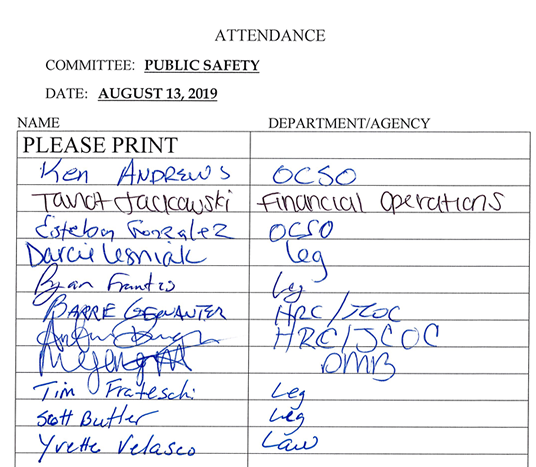
* * *
HEALTH COMMITTEE MINUTES - AUGUST 14, 2019
TIMOTHY T. BURTIS, CHAIRMAN
MEMBERS PRESENT: Mr. Bottrill, Mrs. Abbott-Kenan, Dr. Chase
MEMBERS ABSENT: Ms. Williams
ALSO ATTENDING: Chairman Knapp; see attached list
Chairman Burtis called the meeting to order at 9:37 a.m. A motion was made by Dr. Chase, seconded by Mr. Bottrill to waive the reading of the minutes of the previous committee meeting. Passed unanimously; MOTION CARRIED. A motion was made by Dr. Chase, seconded by Mrs. Abbott-Kenan to approve the minutes of the previous committee meeting. Passed unanimously; MOTION CARRIED.
1. HEALTH DEPARTMENT: Dr. Indu Gupta, Commissioner
a. Informational Update: Rabies, Ticks, Mosquitoes
Chairman Burtis stated that Oswego County found EEE in their mosquitos, but Onondaga County has not.
Dr. Gupta:
Mosquitos:
- Tracking presence of Eastern Equine Encephalitis (EEE) and West Nile Viruse
-
Also have traps in different sites to assess if there are any mosquitos that may carry Zika Virus
-
Program runs from late May – September; 23 trap sites throughout County; traps around Cicero Swamp are collected twice a week; remaining traps are collected once a week
-
Mosquitos trapped, counted, sent to NYSDOH Wadsworth Lab in batches of 50 – receive report, which is put on website
-
Presence of EEE or West Nile has to be reported to the public; implications for both
-
Both create same illness, but EEE is much more severe and causes more fatalities; bigger concern
-
Throughout surveillance – goal to see the trend, total number of mosquitos and presence of virus; compare to last few years for trending; if there is any EEE, then consider spraying
-
Do not want to overwhelm people with illnesses; facts over fear; Health Department has to give the Legislature the talking points and reassure constituents
-
Heart disease number one killer, then cancer and injury; mosquito borne illness not on the list
-
2019 – 126,000+ mosquitos collected; ~460 mosquito pools collected; so far so good; negative virus infection
-
Oswego has positive EEE; mosquitos do not travel that far; Health Department on high alert
-
Identified 500 mosquito breeding sites, and 200 were treated with larvicide to prevent breeding
-
4,000 catch basins treated with larvicide in city, fairgrounds and amphitheater areas
-
Pre-emptive measures, because if 1 infected, then more and more transmission with cross breeding
-
Treat unmaintained swimming pools with mosquito dunks; get order to close pools
-
Spray decision – made based on number of species of mosquitos in traps, finding the virus, location of virus and time in the season; decision made in cooperation with NYSDEC and NYSDOH
Dr. Gupta responded to Mrs. Abbott-Kenan that there are 9 unmaintained swimming pools at vacant properties. Ms. Letteney clarified that these are private swimming pools at vacant houses. Dr. Chase asked how they found these pools. Ms. Letteney responded that neighbors call in, and there is a list of vacant houses they check each year to see if anyone is living in them.
Dr. Gupta orientated the committee with the Health Department’s website, http://ongov.net/health/, showing all the active links, videos, charts and information on mosquitos. Dr. Gupta added that they cannot get rid of mosquitos, because they are part of the ecosystem.
Rabies:
-
Fatal, but preventable; can spread to people and pets if bitten or scratched
-
Rabies in United States (US) found in wild animals like bats, raccoons, foxes - 5% of bats are infected
-
Dogs in US are universally vaccinated - promote clinics; most people compliant; same for cats
-
Rabies virus spread via a bite – it crawls through nervous system to brain; prevention is the key
-
Fortunate to have system in place - after exposure, need medical attention; it travels quickly to the brain, affects the respiratory system, paralyzes muscles, etc.; very few people survive
-
There have been rabies cases in US; case report last year – someone in Virginia got bit in a developing country, then developed rabies later on
-
For those traveling to developing nations or working with wildlife, it is recommended they take vaccine before exposure – pre-exposure prophylaxis
-
Common public no standard recommendation; after bite – go through evaluation by talking to person and provider, then approve if they meet criteria for post-exposure prophylaxis; vaccine given via series of 4 over 2 weeks to protect person
-
i.e.: John Doe gets bit by dog; call provider; Health Dept. gets report and identifies if dog vaccinated; will monitor dog for 10 days; after 10 days, the pet can be vaccinated if it was not, or they can euthanize
-
Staff works with vet hospitals and community members; if animal to be euthanized, it will be tested
- Nurses go into detail to ask questions to find out if there was exposure; use CDC criteria; recommend prophylaxis to anyone that might have been exposed
- Health Dept. approval, because this comes from the department; NYSDOH regulations
Chairman Burtis stated that rabies has been in the news recently, so if someone gets a call or concern, then the Health Department website is the place to go.
Dr. Gupta added:
-
Bat trapping video on the website; people will trap a bat, then let it go; because there is exposure, Health Department has to vaccinate; but only 5% of bats are infected with the virus; do not want to vaccinate if not needed
-
People also like to play with wildlife – i.e. picking up a baby raccoon; the baby raccoon then has to be euthanized, because they are unsure of what it might have
-
Let wildlife be; respect their place and space, so animals do not have to be euthanized
-
Try to communicate this effectively with press release for all summer related diseases; also send provider alert
Deer and Ticks:
-
Lyme Disease is endemic, meaning it’s here; caused by bacteria, and transmitted through bite via Black Legged Tick
-
Symptoms – fever, headache and rash
-
Stay protected – use light covered clothing and insect repellent; check all over after being outdoors
-
Ticks are poppy seed looking; if find tick, remove it immediately - tick removing video on the department website
-
If tick embedded in skin for 36 hours or more, it has time to regurgitate the virus into the person’s system; if person does not know how long tick was there, call doctor for medication; proactive action on both patient and doctor important
-
Lyme Disease complicated to diagnose - testing positive does not mean the person has it; specific guidance on how to consider Lyme disease including detailed history, tests, symptoms; skin rash is clinical diagnosis – no tests needed
-
Post-Treatment Lyme Disease Syndrome – most cured with antibiotic, but difficult to detect infection; symptoms include muscle and joint pain, fatigue, sleep detriments and cognitive deficiencies
-
100% fact - long term treatment is a no; does more harm than good by developing antibiotic resistance
-
Vectors involved in carrying ticks: deer and white legged mice
-
Message is always protect yourself; start from childhood; everything in moderation
Chairman Knapp explained how he found a tick on himself and went to the doctor to be checked out; everything was fine since it had only been 12-14 hours. Shortly after, Chairman Knapp saw a study on News Channel 9 that Upstate wss doing, where a person can send in a tick they removed from them self for testing. It gets sent in via a small bag with a wet tissue, and they only require an email and zip code for records. The email Chairman Knapp received from them after testing said the tick had no viruses. The great thing is that the test was free. Chairman Knapp asked if this study can be added to the website. Dr. Gupta explained that 50% - 60% of ticks in this area are infected with the virus, and they are gradually uptrending. She stated that Dr. Thangamani is the SUNY Upstate Microbiology Lab Director who is studying Lyme disease and other tick borne diseases. Dr. Gupta said Ms. Letteney and Dr. Nguyen, Medical Director, met with the team at Upstate to collaborate, and Upstate will be sharing their results with the County. The data will provide details for targeted messaging. Dr. Gupta did ask about adding the study to the County website, but Upstate has limited research funding for it; they do not have the capacity to continue doing testing. The study and testing are still going on, but it will stop. Ms. Letteney responded to Chairman Knapp that they are getting a lot of ticks, but there is a limit to how many they can do.
Chairman Knapp stated that bats are our friend, because they eat their own weight in mosquitos. Dr. Gupta commented that changes in the environment are affecting the ecosystem. For example, the deer population is high, because of suburban sprawl and no carnivores to eat them.
Dr. Chase asked if Dr. Gupta is involved with the kids who need to be vaccinated before going to school and said her understanding is that physicians trying to keep up are getting out of control. Dr. Gupta asked what Dr. Chase’s source is, and Dr. Chase replied she heard it from several people getting their kids vaccinated. Dr. Gupta replied:
-
If kids are not vaccinated, they get excluded from school; Dr. Gupta receives a letter from the districts with exclusions
-
Immunization very important part of work; protects community from vaccine preventable diseases; i.e. measles, mumps
-
Schools have right to exclude (kids not immunized); last few years, Dr. Gupta got exclusion letters from schools, and talked to director of nursing who oversees immunization program - nurse said it is normal procedure to notify the County
-
Collected data to see what to do to promote services and vaccinate kids; mapped which school districts had exclusions, and identified community based organizations that can promote in the summertime
-
Work with everyone to promote immunization, and communicate why important throughout community and County
-
Asked to do vaccinations at school with school based clinic; County has clinic to provide vaccines for uninsured; those with insurance should go to health care providers
-
In less than a year, there was a 50% reduction in exclusions; continuing partnerships; providers should be proactive in informing community members in June and July to get kids vaccinated
Mrs. Abbott-Kenan asked if there are more uninsured people, or if those insured believe vaccines cause (i.e.) Autism. Dr. Gupta replied that they have not done a study, but the County clinic is open for uninsured individuals. The County has high vaccination rates. Dr. Gupta said she welcomes ideas on how to promote this in other ways, and she said she would be happy to talk to Dr. Chase separately for advice.
2. Memorializing New York State to Increase their Reimbursement Rates to the CNY Mobility Alliance (Sponsored by Chairman Knapp)
Chairman Knapp:
-
Medicaid system provides a benefit of transportation to doctor’s appointments and other things
-
10 years ago, the County handled that as far as negotiating with companies and setting reimbursement rates; State took over 10 years ago, so no longer county function
-
Since then, state handles program by county - each county has different level of reimbursement
-
Medicaid program covers most vulnerable residents in County including the elderly and poor
-
Since state took over, there are increased rates with inflation; nothing is the same from 10 years ago with labor, insurance, fuel and cost of vehicles
-
Most other counties have been increased, but Onondaga County has not seen a fraction of a percent of increase in last 10 years; now in lowest 15% for reimbursement in state
-
Providers seeing less than other rural counties or smaller counties where it may be cheaper
-
Compared to Erie, Monroe and Cortland who are 30% higher in reimbursement
-
Ramifications – lost Able Medical Transport, who went out of business couple months ago
-
Remaining providers are trying to move to other areas that are more lucrative to stay in business, which is cutting back availability to Medicaid patients
-
This is basic medical transport – taking patient to medical appointments like therapies, kidney dialysis, etc.
-
If people cannot get to regular doctor’s appointments and conditions get worse, then not paying for medical transport, but an ambulance to the emergency room
-
Trying to figure out what’s going on with the state, who seems to be determined not to help local community
-
Put together memorializing resolution to go to state and local representatives
-
Talked to Social Services locally, and it will not have impact, because 8 years ago state capped Medicaid contributions
-
This would still put the County below other counties, but would get the County within the ballpark; looking at doing a gradual approach versus dramatic increase
-
Trying to figure out why it happened; similar large counties have seen increase, but not here
Chairman Burtis stated that CNY Mobility Alliance has the proposed rate schedule, and Chairman Knapp commented that they have been talking to the County, the County Executive and Mayor. They are hoping to get the same out of the City of Syracuse.
Dr. Chase stated the resolution says, “Approve Door to Door Mileage within City”, and Chairman Knapp interjected that he did notice that, and it will be tweaked before it goes to session.
A motion was made by Dr. Chase, seconded by Mrs. Abbott-Kenan, to approve this item. Passed unanimously; MOTION CARRIED.
Chairman Burtis added that he had a resident recently looking for help, and it was more intense than it should have been. She was in need of a ride to get to her chemotherapy appointments, and she was not doing well to the point of borderline ambulance. Family members are worried something may happen while in a personal vehicle. Chairman Burtis said thank you to Chairman Knapp for bringing this forward. Chairman Burtis responded to Dr. Chase that they reached out to everyone including the American Cancer Society, and this situation greatly concerned him.
Mrs. Abbott-Kenan thanked Dr. Gupta and her staff for working with her on vaping, and she will be bringing it forward in the future. The new data on middle school students is awful. Her interest is in communication, and there is a targeted plan. Dr. Chase suggested the Prevention Network. Mrs. Abbott-Kenan said that the County has done a great job with the County Task Force, because schools do not have the where with all to take something like this on. In her opinion, the community is going backwards from getting people off cigarettes to a worse arena. Mrs. Abbott-Kenan was thrilled with the age change the Legislature approved previously and said the Health Department can be an awesome vehicle to give school districts the tools to educate.
A motion was made by Mr. Bottrill, seconded by Mrs. Abbott-Kenan, to adjourn the meeting. Passed unanimously; MOTION CARRIED.
The meeting adjourned at 10:28 a.m.
Respectfully submitted,

JAMIE M. McNAMARA, Assistant Clerk
Onondaga County Legislature
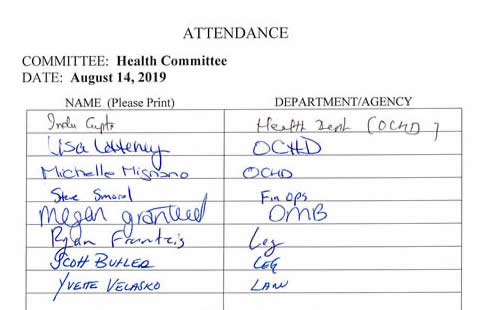
* * *
WAYS AND MEANS COMMITTEE MINUTES
August 16, 2019
DEB CODY, CHAIR
MEMBERS PRESENT: Mr. Jordan, Mr. Rowley, Mrs. Ervin, 1Mr. Ryan, 2Mr. May
MEMBERS ABSENT: Ms. Williams
ALSO PRESENT: Chairman Knapp, Dr. Chase, see also attached list
Chair Cody called the meeting to order at 9:06 a.m. A motion was made by Mrs. Ervin, seconded by Mr. Jordan, to waive the reading of the minutes of the proceedings of the previous committee meeting. Passed unanimously; MOTION CARRIED. A motion was made by Mr. Jordan, seconded by Mrs. Ervin, to approve the minutes of the proceedings of the previous committee meeting. Passed unanimously; MOTION CARRIED.
1. ONONDAGA COUNTY CIVIC DEVELOPMENT CORP.: Mary Beth Primo, Deputy Co. Exec./Physical Svcs.
a. Confirming Reappointment to the Onondaga County Civic Development Corporation (Matthew J. Marko)
- Served on board for a number of years; done very well during tenure
- Resume provided for review/certainly qualified
- County Executive requests support for this appointment
A motion was made by Mr. Rowley, seconded by Mr. Jordan, to approve this item. Passed unanimously; MOTION CARRIED.
2. ONONDAGA COUNTY/SYRACUSE COMMISSION ON HUMAN RIGHTS:
a. Confirming Appointment to the Onondaga Co./Syracuse Commission on Human Rights (Ali Adan)
- Resume provided/appears qualified to serve on this board
- County Executive requests support for this appointment
A motion was made by Mrs. Ervin, seconded by Mr. Rowley, to approve this item. Passed unanimously. MOTION CARRIED.
3. LEGISLATURE: Deborah Maturo, Clerk of the Legislature
a. Standard Work Day and Reporting Resolution
- Next round of Standard Work Day report as required by NYS
A motion was made by Mr. Jordan, seconded by Mr. Rowley, to approve this item. Passed unanimously; MOTION CARRIED.
4. TRANSPORTATION: Martin Voss, Commissioner
a. Amending the 2019 Onondaga County Budget to Accept $759,195 in Extreme Winter Recovery Funding from the New York State Department of Transportation, and Authorizing the Execution of Agreements ($759,195)
- Accept from NYS DOT Emergency Winter Recovery funding allocation – part of supplemental capital budget passed by the State Legislature in June
- A list of projects has been submitted, approved by the Co. Executive and Chairman of Legislature, for additional work to be done with this money
1Mr. Ryan arrived at the meeting.
Mr. Rowley asked how DOT is doing this summer with paving projects, etc. Mr. Voss said they are doing well. It rained the entire months of May and June, which didn’t help things. There has been a dry run and are getting caught up. Some key bridge projects are moving forward. One in Manlius was touch and go, but figured out a way to get it done – don’t like of have big projects carry over through winter into the following Spring. Doing everything they can to move the Electronics Parkway project along.
Mr. Jordan asked about the Taft Road project. Mr. Voss agreed that it is disruptive; it is moving slowly; appreciates the public’s patience. He said that they push and push to get as much done as they can with the limited construction window, before it starts snowing. In answer to Mr. Jordan, Mr. Voss said that the project is on track. He added that there have been a lot of gymnastics with OCWA and other utilities.
Chair Cody said that there new project on Morgan and Buckley. Mr. Voss agreed and said the Freemont Road is starting on Monday.
A motion as made by Mrs. Ervin, seconded by Mr. Ryan, to approve this item. Passed unanimously; MOTION CARRIED.
5. PARKS AND RECREATION: William Lansley, Commissioner
a. Accepting Donation from Friends of the Rosamond Gifford Zoo, and Amending the 2019 County Budget ($30,000)
- Accept $30K from Friends of Rosamond Gifford Zoo in conjunction with the elephant boardwalk
- Original budget included hydraulic gates, pedestal mounted; for the safety of the staff and elephants, a decision was made to upgrade to a remote – all gates can be controlled from a single standpoint in the facility
2Mr. May arrived at the meeting.
Mr. Lansley said that the boardwalk project has been completed and offered a tour; it is a remarkable improvement for the zoo.
A motion was made by Mr. Jordan to approve this item.
Mr. Ryan said that he was at the zoo a couple of weeks ago and it looks really good. He knows a lot of it is because of the Friends. He said that we should be proud of the zoo. Mr. Lansley said that they recently held a $1 day and had almost 5,000 people there.
Chair Cody said that there an event coming up with the elephants that looks interesting. Mr. Lansley said it is the Elephant Extravaganza. He said that boardwalk project will accommodate a lot more people because now there are two wings. The elephants love the yard, as they have another several acres. There is ability to open and close yards for various seasons, etc. It is one of the premier breeding facilities in the United States.
Mr. Rowley asked when groundbreaking is anticipated for the new medical elephant facility. Mr. Lansley said that the design is done. There are two water mains on the property--a lot of utilities there. They have been coordinating with the City and National Grid on how to best situate the building on the property. It has been a bit of a challenge --now just need to put it into a footprint where it can be built without putting any pressure on the water system. He thinks that it will be put out to bid in a couple of months; expects it will be built throughout the duration of next year and opening late next year.
Mrs. Ervin asked if it will still be completed in time to make sure we are in compliance. Mr. Lansley said “absolutely”. He said once it is in motion, the AZA is good with it and knows it is going to happen.
Mr. Jordan asked Mr. Lansley to please thank the Friends; they are one of our greatest partners. The zoo would look very different than it does now, if it weren’t for the efforts of the Friends. They do an outstanding job.
Mrs. Ervin seconded the motion. Passed unanimously; MOTION CARRIED.
6. WATER ENVIRONMENT PROTECTION:
a. Authorizing the County Executive to Enter into a Contract with the United States Department of the Interior for the Operation and Maintenance of Stream Gaging Stations in the County of Onondaga
No department representative was present. Mr. Jordan said that this is the stream gaging that is an obligation under the ACJ. It’s an arrangement that has existed for a number of years. The cost is approximately $114,000; the county’s share is 65%. In answer to Mr. May, Mr. Jordan confirmed that the contract is renewed every year.
A motion was made by Mr. Rowley, seconded by Mr. Ryan, to approve this item. Passed unanimously; MOTION CARRIED.
7. 2020 CENSUS – Informational Presentation: Chris Iven, Partnership Specialist, New York Regional Census Center
Mr. Iven introduced himself and Jerry Lord from the US Census Bureau. He also introduced Tory Russo, the City of Syracuse Coordinator. He noted that her counterpart for the County is Susan Boyle.
He presented and review the following presentation:
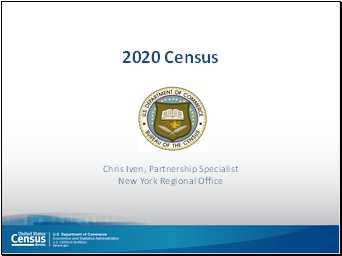
Introduce self. I’m here because the 2020 Census will be here before you know it, and we need to prepare to make it successful. I’m also a resident of Central New York. I care about this community. And I know you do, too. You’re here because, as community leaders, your role will be more important this year than ever.
- Ask who’s in the audience by show of hands: Business leaders. Nonprofit leaders (executive and board), elected officials, appointed government officials, anybody else? Thank them for attending and for all you do to help your community grow and thrive.
- As strong leaders, you crave information on how to strengthen your communities. I’m here to tell you that the US Census is central to your aims. If I do my job well today, you’ll leave knowing that the U.S. Census is: IMPORTANT, it’s SAFE and it’s EASY, and that YOUR COMMUNITY NEEDS YOU to help ensure that everyone gets counted once, only once and in the right place.
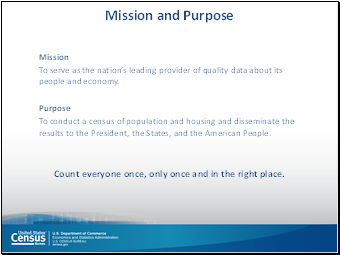
Step back: What is the Census Bureau?
- The Census Bureau serves as the nation’s leading provider of quality data about its people and economy.
- Our most important purpose comes from a mandate in the U.S. Constitution: The Census provides Census data to the Federal Government, State Governments and the American People.
- The goal of the 2020 Census is to count everyone once, only once, and in the right place.

We’re experts on stats
The Census Bureau doesn’t just count people every 10 years. We’re the largest statistical agency in the U.S. because we’re very busy gathering data at all times. In fact, we conduct more than 130 Censuses and Surveys.
- Census is counting. It’s the gold standard and it occurs every 10 years.
- American Community Survey = long form, jobs and occupations, education, veterans, rent/own. The American Community Survey is an ongoing survey that provides vital information on a yearly basis about our nation and its people. Through the ACS, we know more about the occupations, educational attainment, ancestry, disability, veteran status, language proficiency and many other characteristics of our population.
- Current Population Survey – Labor Statistics. One of the oldest, largest, and most well-recognized surveys in the United States. The Current Population Survey is sponsored jointly by the U.S. Census Bureau and the U.S. Bureau of Labor Statistics and is the primary source of labor force statistics for the population of the United States. Data from the Current Population Survey is used to calculate the unemployment rate.
- American Housing Survey: The Census Bureau also conducts the American Housing Survey to provide a current and continuous series of data on selected housing and demographic characteristics. Policy analysts, program managers, budget analysts, and Congressional staff use American Housing Survey data to monitor supply and demand, as well as changes in housing conditions and costs, in order to assess housing needs.
- Other surveys for other governmental agencies.
- Economic Census – 4 million businesses - is the most extensive collection of data related to business activity. Every five years, in years ending in 2 and 7, the U.S. Census Bureau collects extensive statistics about businesses that are essential to understanding the American economy. This official count, better known as the Economic Census, serves as the foundation for the measurement of U.S. businesses and their economic impact. As part of the Census Bureau’s mission to provide timely information on the health of the U.S. economy, this “business” census serves as the most extensive collection of data related to business activity. Nearly 4 million businesses, large, medium and small, covering most industries and all geographic areas of the United States will receive surveys tailored to their primary business activity.
- Census of Governments. The Census of Governments is also conducted in years ending in years ending in 2 and 7. The Census of Governments identifies the scope and nature of the nation's state and local government sector; provides authoritative benchmark figures of public finance and public employment; classifies local government organizations, powers, and activities; and measures federal, state, and local fiscal relationships. Information provided by the Census of Governments include; how governments are organized, government employment and payroll, and government finances.
- Both the Economic Census and the Census of Governments have related surveys that are conducted quarterly and annually to provide ongoing insight to the United States public and private sectors.
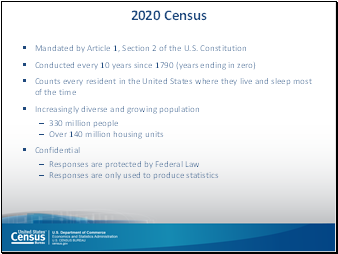
Let’s get started with the 2020 Census….
As I mentioned, the Census is mandated by Article 1, Section 2 of the United States Constitution. Why? Because it’s
IMPORTANT.
The primary purpose of the decennial census is to apportion seats in the U.S. House of Representatives among states. Our republic is founded on the principle of equal representation. That’s why our constitution calls for votes in the house of representatives to be apportioned based on population. States with more people get more votes. Well, it’s impossible to be fair if we don’t know how many people are in each state. That’s why our founders enshrined the decennial (every 10 years) census in Article 1 of the U.S. Constitution
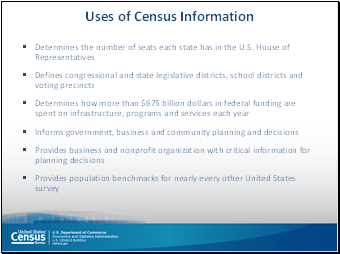
Why do we conduct the Census? Besides apportionment for the U.S. House of Representatives….
- States and local governments use Census data to draw congressional and state legislative districts, school districts and voting precincts.
- Federal Agencies use Census data to distribute over $675 billion each year to the states. As one of the largest states, you can only imagine how much that means for the state of New York.
- The Census also drives policy decisions. Census data are used by federal, tribal, state, and local governments to make informed decisions for their communities.
- Businesses use census data to make critical decisions about where to locate businesses. Will they have enough customers? Will they have enough workers? Good information can make or break a business.
- The same is true for nonprofits. OK, nonprofit leaders in the room. Raise your hand if you’ve applied for a grant that required census information.
In short, Census Data is used to shape our future. And by participating, you and every member of your community has a chance to help shape that future. That’s why the 2020 Census tagline is: “SHAPE YOUR FUTURE. START HERE.”
So, that’s the first thing you need to know. THE CENSUS IS IMPORTANT.

The second key point is that the CENSUS IS SAFE
To help shape our future, census data must be accurate. That means we have to personal questions such as people’s names, ages, sex, and race, but – and this is very important –we only release composite snapshots of communities. We never release personally identifiable information. Protecting personally identifiable information is our top priority, and it’s a legal requirement. Again, our primary goal is to count every person once, only once and in the right place. Without people’s trust, we won’t succeed.
That trust is so important, it’s enshrined in law, specifically Title 13 of the United States Code. These laws not only provide authority for the work we do, but also provide strong protection for the information we collect from individuals and businesses. The laws specifically state that:
- Personal information collected by the Census Bureau cannot be shared with any government agency or court.
- Census Bureau employees are sworn for life to protect confidentiality.
- Violating the law is a serious federal crime. Penalties include a federal prison sentence of up to five years, a fine of up to $250,000, or both.
- And those penalties don’t just apply during our time at the Census Bureau. They apply for our entire lives.
- The law has been challenged in court many times over the decades, but it has never been overturned. It would take an act of Congress to change it.
- Data is encrypted on the way in, and it’s stored behind the strongest firewalls available.
So, the Census is SAFE
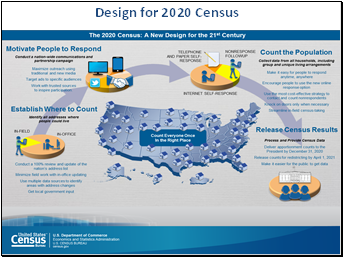
The Census is also easy!
You folks are community leaders. You know that in order to make something easy, you’ve got to put in a lot of hard work, right?
This slide gives an overview of the hard work we’ve done and plan to do to make it easy for everyone to complete the census.
1. It starts with first knowing where to count people. We maintain a Master Address File. It was created for the 2010 Census, but since then, it’s been updated with regular updates from the Postal Service, staff updates from work on current surveys, and input from local governments through the LUCA program. We even have a program to anticipate where houses will be built between now and Census Day 2020 to ensure we don’t miss anything. This list makes everything else easier. By the way, some thanks are in order for some of you. New York is the only large state in the nation in which every county participated in the 2020 Local Update of Census Address (LUCA) process. If any of you were involved in that, thanks for making everything easy for everybody else.
2. Then, we need to motivate people to respond. Just as we did in 2010, you’ll see advertisements on TV and billboards. For 2020, we’ve engaged a group of ad agencies that specialize in reaching groups that are typically less likely to respond to the Census. You’ll also see targeted online ads and social media campaigns. But, based on our experience from 2010, we know that the most important outreach effort for those hard-to-count populations is old-school social media. That is, using existing relationships. People are more likely to do something when someone they trust says it’s important, safe and easy. This is where you and I come in. I’ll get more into that in a moment.
3. Finally, we have to count the population.
- This operation will start with a postcard sent to every single address in our Master Address File. Everybody who gets one will be asked to visit a website, enter a code that corresponds with their address, and fill out the form. Quick, easy, done.
- This is the first time ever that people have been able to complete the Census online. We’re doing it because it’s easier, faster, far less costly, and results in better Census data. That’s why we want as many people as possible to complete the Census on time and online.
- Remember, our goal is to count everyone once, only once and in the right place. This new technology will also allow people to fill out the form using their smart phone, even if they don’t have their address code handy.
- A week or so later, everyone will get another postcard reminding them that they should fill out the form online, or, they can call a toll-free number and have someone take their answers over the phone. Again, 2020 is the first year we’ll have the ability to take the Census over the phone.
- If we don’t get a response online or by phone, by mid-April we’ll send a paper questionnaire to any nonresponding housing unit. In other words, for those of you who would rather fill out the paper form than go online or make a call, you can do that.
- We’ll send other reminder mailings, but if we don’t get a response from a particular address, we will eventually send an enumerator. This is the most expensive way to gather information, so we want to avoid this if possible.
4. Finally, once all the information is in, compiled and analyzed, we deliver the counts to the President of the United States by December 31, 2020, and to the states by March 31, 2021.
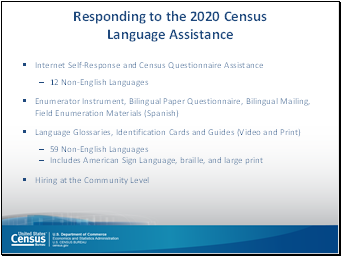
We want to make the Census easy no matter what language you speak.
Because we really want people to respond on their own, we have developed a strong language assistance program.
- Mailings will be bilingual in English and Spanish.
- Online response will be supported in 12 non-English languages, as will our telephone questionnaire assistance (Spanish, Chinese, Vietnamese, Korean, Russian, Arabic, Tagalog, Polish, French, Haitian Creole, Portuguese, Japanese)
- We also plan to have language materials, such as language guides, available in 59 non-English languages.
- Hiring locally to get folks who are more likely to speak the language and understand the culture.

Language graphic
This shows visually our non-English language outreach efforts.
People will be able to fill out the form online or get phone assistance using the 12 languages in the middle.
In all, people will be able to get help in 59 languages – the rest of the languages on the screen – including American Sign Language.
The rest of the 59 non-English languages
We want to make the Census easy no matter what language you speak.
Because we really want people to respond on their own, we have developed a strong language assistance program.
- Mailings will be bilingual in English and Spanish.
- Online response will be supported in 12 non-English languages, as will our telephone questionnaire assistance (Spanish, Chinese, Vietnamese, Korean, Russian, Arabic, Tagalog, Polish, French, Haitian Creole, Portuguese, Japanese)
- We also plan to have language materials, such as language guides, available in 59 non-English languages.
- Hiring locally to get folks who are more likely to speak the language and understand the culture.
Again, we’re doing all we can to make the Census EASY.
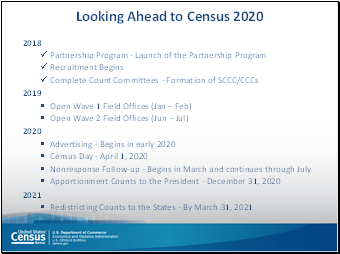
We have a plan!
There’s a lot of work to do, and it’s already underway. Here is a summary of key milestones as we prepare for the 2020 Census.
- This year, we’re hiring staff throughout the region. We are going to be hiring more Partnership Specialists (like me), office staff for the field offices and field staff to conduct some of the early in-field operations.
- Recruitment for a lot of these jobs will begin this summer and I’ll keep you updated of when they become available.
- As we move into fall, you’ll start hearing more about the Census. The buzz will begin. In early 2020, the media campaign will be in full swing as we prepare for Census Day, April 1.
- We will begin ringing doorbells in March and continue through July 2020.
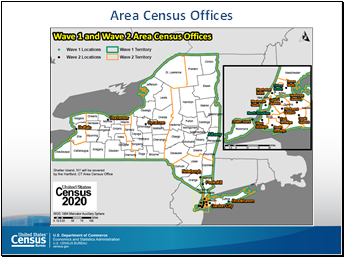
We’re hiring, here and now!
To coordinate this massive effort, we’re staffing offices all across the country.
Right now, the field office for Upstate New York is in Albany, but this summer, we plan to open a total of 21 field offices throughout the state, including one in Syracuse. The Syracuse office will cover the central part of the state, from Broome County to St. Lawrence County.

Who are we looking for?
We have office positions and field positions. By far, the majority of staff positions will be field supervisors and enumerators. These are the folks who will be most active during our non-response follow up operation in 2020. That’s when we visit the households who did not self-respond.
If you know of somebody who might want to apply for these positions, please pass along this information: Partnership Specialist and management positions can be found on USAJobs.gov. All other positions can be found at 2020Census.gov/jobs.
Again, as community leaders, we want to work with you to identify people who could benefit from these jobs and who could do a good job in reaching out, especially to hard-to-count Census tracts.
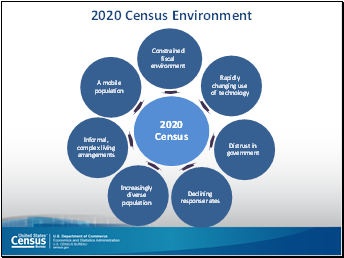
What are We Up Against?
We’re not operating under any illusions. In some ways, the 2020 Census will be more difficult than ever. It will be conducted in a rapidly changing environment, requiring us to be flexible. This image shows some of the major challenges we expect:
- Constrained fiscal environment: We need a complete count, but we know we don’t have an unlimited budget to make that happen. We want to be responsible with US tax dollars.
- Rapidly changing use of technology: People are using technology different than they did in 2010. They have higher expectations, and we have to respond. Our innovations promise more efficiency and higher quality results, so one challenge is making sure all of our new systems work well before we launch.
- Distrust in government: All of us have heard about data breaches. Concerns about that continue to grow, as do concerns about how the government will use the information collected. I want you to know that the U.S. Census Bureau is a professional, statistical agency. We have no agenda other than to count people. We are interested in people, not politics.
- Declining response rates: Response rates for Census Bureau surveys and censuses and for surveys in general have declined as people are overloaded with requests for information. People are inundated with information and one more request can feel like too much. We recognize that we need to combat the apathy and motivate people to respond.
- Increasingly diverse population: The demographic and cultural make-up of the United States continues to increase in complexity, resulting in a growing number of households and individuals who do not speak English as their native language, who have a wide variety of cultural traditions and mores, and who may have varying levels of comfort with government involvement.
- Increasingly complex living arrangements: Households are becoming more diverse and dynamic, making it a challenge to associate an identified person to a single location. For example, blended families may include children who have two primary residences. Additionally, some households include multiple relationships and generations.
- A very mobile population: Based on data from the American Community Survey, the population of the United States continues to be a highly mobile, as about 12 percent of the population moves in a given year (2012-2013 and 2013-2014 ACS Data).
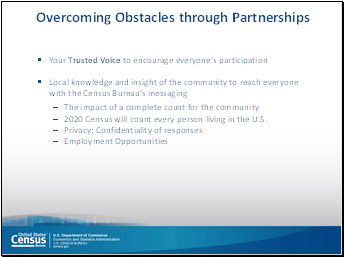
We need you!
With all these challenges, we know we need help to ensure that everyone gets counted. We have lots of help on the national level, but we really need it on the local level, where the Census is actually completed. That’s what our Partnership Program is all about. We are reaching out and developing relationships with local leaders and stakeholders – community leaders just like you. Partners have knowledge and insight of their community that the Census Bureau might lack. Those relationships are critical in helping us reach everyone.
We need our partners to help
- Raise awareness of the 2020 Census in your communities
- Recruit staff we need to get the job done
- Motivate the people you serve to respond – for their own good, for the good of their community, as well as their city, state and nation.
Our partners’ trusted voices carry weight and influence in the community. With your help, we’ll succeed.
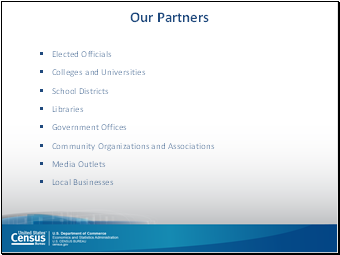
Who can be a partner?
We want to partner with every trusted voice in the community. That’s everybody you see on this list. And I would add one more: Anybody who wants their community to grow stronger. With that addition, I think you’ll find that you belong on this list. You can be a partner in strengthening your community!
Trusted voices in the community have the power to motivate diverse communities to participate in the Census, mobilize other community leaders to engage their constituents, and reach populations with historically low response rates and who are considered hard to count.
For reference:
- Elected Officials – As leaders in the community, the public often reaches out to them for guidance on various topics.
- Colleges and Universities – Counting the student body will be difficult. Colleges and universities will be able to deliver the census message to students with their own census campaigns.
- School Districts – Educators are trusted voices in communities. Educators are resources for the community. Also, by utilizing Statistics in School materials students are being exposed to the Census Brand.
- Libraries - Libraries are another community resource that the public turn to for information. Also, public libraries are equipped with technology that public can use to apply for census jobs and/or respond to the census.
- Government Offices - Government offices at all levels are a public resource. They can use their knowledge and interaction of the community
- Community Organizations and Associations - As community resources in the community, the public often reaches out to them for guidance on various topics.
- Media Outlets – Media outlets are able to reach the community with broadcasting census public service announcements on the employment opportunities and response to the Census.
- Local Businesses – As established resources in the community, businesses can share the Census message their employees and share the census message with their customers.
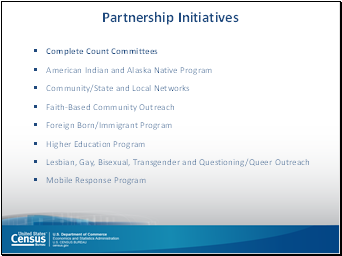
Partnership Initiatives
The Census Bureau has special initiatives to ensure that every community in the United States is reached. And, we hope to engage our partners to help us with these efforts.
- Complete Count Committees will be instrumental in the 2020 Census. This is a group of community stakeholders who come together to identify any obstacles and solutions to ensure that their communities participate in the 2020 Census. More on that in a moment.
We will also have other initiatives that target specific population groups. In other words, we’ll have partnership specialists statewide who are especially well suited to reaching out to the groups you see here.
For reference:
- American Indian and Alaska Native Program focuses on support Federal Recognized, State Recognized, Non Recognized and AIAN living on and off Tribal Land. The program includes Tribal Government Liaison program, Tribal Complete Count Committees (TCCCs) and partnership with Organizations supporting AIAN populations.
- Community/State and Local Networks. We will form relationships and partnerships with local organizations in the community working with populations in low response score areas to help them understand the benefits and impacts of the 2020 Census. These partners will help us promote self-response and add value to the census by providing the use of their established communications network.
- Faith-Based Community Outreach focuses on engaging faith-based leaders as census ambassadors. These leaders will promote the census and motivate their congregations or members to participate in the census. Faith-based partners are especially helpful in specific ethnic communities and other low response areas.
- Foreign Born/Immigrant Program has a crucial role in conducting an effective outreach to the foreign born population and will contribute to the ultimate goal of reducing the undercount during 2020 Census. There is an increased fear of deportation and distrust of governmental agencies within the immigrant communities. We need to respond with innovative strategies for overcoming this population’s fears to accomplish the mission.
- Higher Education Program is to conduct outreach to all enrolled students and surrounding communities (typically students who live off campus). The Higher Education Program for the 2020 Census will include four-year colleges and universities, community colleges, vocational schools, trade schools, adult educational facilities and other career colleges.
- Lesbian, Gay, Bisexual, Transgender and Questioning/Queer Outreach LGBTQ communities often have similar experiences that are common among populations living in low response score areas such as historical mistreatment and high levels of stigmatization. We will integrate LGBTQ outreach into existing efforts to reach people living in low response score areas and improve outreach.
- Mobile Response Events will be identified through the local knowledge of census staff and community leaders. These outreach events will give the public the opportunity to self respond using mobile devices to complete the 2020 Census.
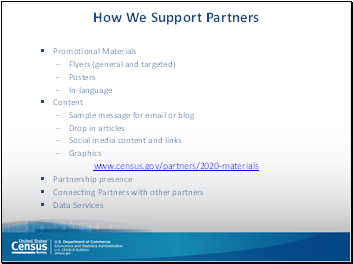
What we can do for you
We know that our partners are very busy and we want to make it easy for them to help.
- We want you to have all the information you need to be successful. We will provide partners with printed and digital materials to deliver Census messages to the people you serve. That includes sample email messages, pre-written drop-in articles, social media content that you can customize and share with the people you serve. Pre-printed fact sheets and promotional material is available on request.
- We’re also eager to come to your events. Job fairs, community socials, gatherings of any sort. These events allow us to engage directly with the community and address any of their issues.
We will be here to support you every step of the way, and look forward to working directly with you.
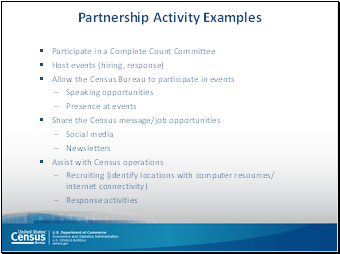
Creative Solutions Ahead
What are partners obligated to do? Nothing more than you’re willing to commit to.
Every partnership is unique. Working together, we’re going to develop great ideas to connect with the people you serve. Some common examples of what other partners have done are on this slide. One I’d like to highlight is providing public access to computers. The city of Syracuse is among the top 10 in the nation with the LEAST access to broadband. That means that libraries, community centers, our local community college and other organizations with multiple computers can be a huge help to ensure that everyone gets counted.
For reference:
- Participate in a Complete Count Committee. More on that in a moment.
- Hold an event to raise awareness about the Census or about Census employment opportunities. We’d love to get some media attention to the work we do.
- Allow Census Bureau staff to be present at your events. This is huge because your events give us credibility with the people you serve.
- Share the message through social media or your newsletters. We provide you pre-packaged the information so all you have to do is drop it in your social media or newsletters.

The Power of Complete Count Committees
- While Partners can do great things on their own, working together, they can work wonders. A Complete Count Committee harnesses the energy of partners and the power of teamwork to have a much greater effect on their community.
- A CCC is made up of a broad spectrum of government and community leaders – the same kind of people who can be partners. The only requirement is that they’re inclusive, non-partisan and dedicated to raising awareness about the Census and Census jobs, and to motivating people to respond to the Census.
- Working together, using their knowledge and connections, CCCs develop and implement a community-wide awareness campaign.
- CCCs operate independently from the Census Bureau, but they’ll get lots of support, training and guidance from me and the partnership program.
- CCCs are made up of local leaders and influencers, people who are trusted in their communities. They’re well positioned to recruit other committee members who have the expertise needed to reach the most hard to count populations. Many CCC members also have access to resources that will be needed to supplement the Census Bureau’s promotional efforts.
Committees are being formed at the state level, regional level, municipal level and at the community level. If you don’t yet have a CCC for your community, we can help you get started when you are ready to form one. Just reach out to me through the contact information you’ll see at the end of this presentation.
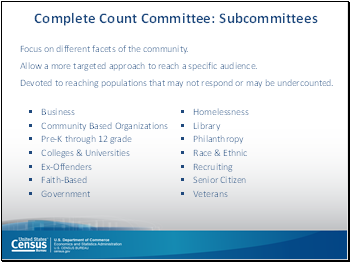
Sharing the Load
Larger communities tend to have large Complete Count Committees. Larger committees can form subcommittees to focus on specific parts of the community. Subcommittees allow for a more pointed approach - they can devote their efforts to reaching a particular audience that may need a greater level of education or motivation before responding.
You can see some of the subcommittees that we expect some CCCs to form. Other communities might have fewer or more subcommittees. This approach will be critical in reaching some of the hard-to-count groups.
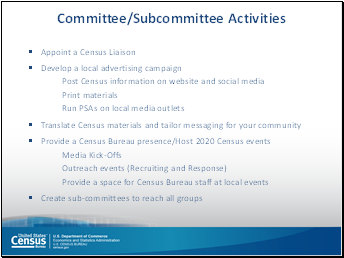
We expect Complete Count Committees will be active. These are some of the activities you can expect from them.
At the top of the list there, you’ll see “Appoint a Census Liaison.” Syracuse can put a checkmark next to that. Thanks again, Tory!
Questions about any of this?
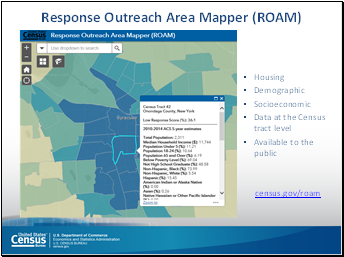
Targeting Our Efforts
At the Census Bureau we believe in taking a data-driven approach to solve problems. To that end, we have developed a tool that can assist Partnership Specialists and community leaders to plan at the local level where we anticipate a low response.
You are looking at a screenshot from an interactive mapping application called the Response Outreach Area Mapper, or ROAM. This tool was developed to make it easier to identify hard-to-survey areas and to provide a socioeconomic and demographic characteristic profile of these areas using American Community Survey (ACS) estimates. ROAM allows the user to visualize areas that are considered hard to survey down to the census tract level. The hard-to-survey areas are represented by the darker shading. Each tract has a Low Response Score, which represents the predicted non-response rate.
Areas can be hard-to-survey for different reasons. Drilling down and learning about these areas allows us to create a tailored communication and partnership campaign, and to plan for field resources including hiring staff with language skills.
The ROAM website is pretty straightforward… Simply highlight a census tract by clicking on it, and view the characteristics of that tract.
This tool is available for public use at the website shown.
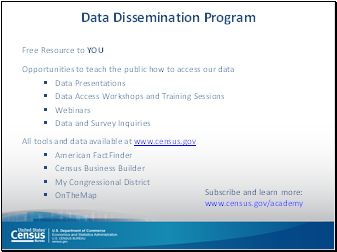
Census data is yours and its free
ROAM is just one way we share Census data. Our Data Dissemination Program is robust, it’s free and designed to make Census data available for everyone to use.
We have a vast array of information available through our website and it can be intimidating for novices. We have lots of great learning tools available at census.gov/academy. In addition, our expert staff can customize a training workshop for you or your constituents. Trainings can be done in person or via webinar. Our staff are well-versed in the data tools available on our website, including American FactFinder, Census Business Builder, My Congressional District and others.
One way we share Census Data is through a program called Statistics in Schools. It provides teachers with age-appropriate, classroom-ready tools that are aligned with what kids need to learn to succeed. There are lessons on history, geography, English, math and sociology, as well as fun facts such as which states have the most toy manufacturers.
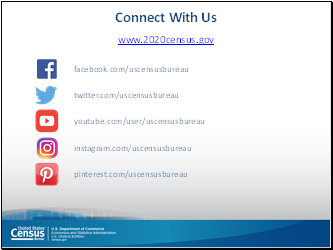
We are very active on social media, so please like, follow or add us!
This is a great way to get content you can repost in your social media to ensure that the people you serve get the message.
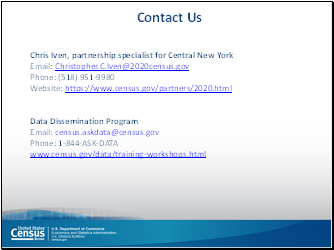
Thank you for taking the time to listen to me. In a moment, I’ll try to answer your questions. But if you don’t hear your question answered, don’t hesitate to contact me. My info is on the screen there. If I don’t know the answer, I will find someone who does and get back to you.
So, the Census is next year, but now’s the time for community leaders like you to start spreading the word that the Census is Important, it’s safe and it’s easy. This is our once-in-a-decade opportunity to shape our future. We need to get ready. We need you. Let’s start here.
And now, I’ll be happy to answer your questions.
Mr. Ryan asked how the word is getting out about the jobs. He said that he represents an area of the city that speaks a lot of different languages – he questioned how recruiting is done. Mr. Iven said that he has flyers in many languages on the importance of being a Census taker, and will provide them to Mr. Ryan. He said that you will see the flyers at job centers; saw flyers downstairs encouraging Census takers; are reaching out in every way possible and are making good progress. There are a certain number of applicants and we can hire a certain amount of people; hope to hire 1,000 in Onondaga County. Mr. Ryan suggested working with the County in conjunction with the City and the libraries in the city. A lot of the training is done in the libraries, specifically the north side, at the White branch. Mr. Iven said that he would check, but was pretty sure they are doing that already.
Mr. Jordan asked when the work starts. Mr. Iven said that they are doing some work right now. The enumerators will start in January with training – ramping up February, March and April; they will have a job through July. The jobs are temporary, but people who have had these jobs in the past talk about having a really great experience. It is good for a lot of people – i.e. stay at home parents, someone right out of prison. You have to be a U.S. citizen and at least 18 years of age. Enumerators are paid $17/hour; supervisors are paid a little more.
Mr. May asked if it can be assumed that the Census Bureau has the likely places covered -- i.e. town and village clerks’ offices -- for not only canvasing and recruiting workers, but also to inform the public of the process; and that we don’t need to reinvent that wheel. Mr. Iven said that they are getting there; if you don’t see a Census flyer at your local town office, let them know. Mr. Iven said that is their intent – he thinks recruiters have done and gone to all the libraries. They are in the process right now of motivating people to respond.
Mr. May asked where the hot spots, the trouble spots are and can they be defined – the areas that we should be more sensitive and aware of that would allow us to be more helpful. Mr. Iven said that the ROAM (website) offers geographic hot spots. The ones you would think of that are vulnerable are immigrants, refugees, those that don’t speak English, people that are too busy to be bothered by the Census. He said that kids under age 5 get under counted because some groups think that because they aren’t in school, they don’t put them on the form. There is education involved in this. Mr. May said that vulnerable populations tend to be the more difficult to get. Mr. Iven agreed and said that another example is homebound seniors, and they work with Meals on Wheels; work with human services agencies.
Mr. Jordan said that it would seem that really highlighting that personal information would not be revealed to anybody, including government agencies, would have a big impact on the response. People may be afraid of responding, but it if they know that personal information is completely iron clad and can be disseminated by law to anybody else, it would certainly ease some concerns that people may have. Mr. Iven said that there is a lot of fear, but it is safe and protected – it’s right in the Constitution.
Mr. Ryan said this is really important. He said that two parts of his district – one is the Census track within the 13204 zip code, which is predominately non-English speaking. Another Census track on the north side is more of a refugee community, which is representative of Congolese, Bhutanese, Somalian, Vietnamese, and is hopeful that we get these Census tracks’ data right. Unfortunately, on a high level there is a fear, hatred, racism, that has been spread by “we know who.” He said that he thinks there is going to be a problem with collecting the Census data. It’s unfortunate; hopeful to work with the libraries -- get the word out that the Census data isn’t going to be tracked. Mr. Ryan said, “I don’t think that we can’t underscore what is happening in this country right now.” Mr. Jordan said that in those areas, we can contract people in those community. We can educate them, and get them paid $17/hour to go out and knock on their neighbors’ doors and assure them that the information is needed and that it will not go to any other government agencies. Hopefully they can allay any fears that people may have.
Mr. Iven clarified that when enumerators are knocking on doors, it is at the end of the process—they are mopping up. He said that they really want people to be on the front end of that – that is why were are working and identifying those communities that are in those Census tracks – working with agencies that have that trusted voice. They are good ambassadors. Ms. Russo said that it is important identify trusted messengers in each Census tracks where we know there are reasons that people might be afraid. She said that she has been meeting with leaders of organizations, community leaders, etc. and coming up with ways to get that information out. She said that she would be happy to talk to Mr. Ryan more about it. Mr. Iven said that the more people we make aware, the more likely we are to succeed.
Chairman Knapp said that this is absolutely appropriate that this presentation came to Ways & Means. This can have an effect in of billions and billions of dollars of government funding, which would all come through this committee. New York is looking at losing one, and potentially two, congressional seats. It is important that everybody gets counted, so we make sure that we keep the damage to a minimum. He said that it is the political season, and many members are out knocking on doors. He suggested mentioning to constituents that they will get something in the mail from Census in April and that it is really important that they respond to it. Show everyone that it is secure. It is really important that this is a non-political process. He referenced Mr. Ryan’s comments, and said “I don’t think we need to go there”. The more we keep politics out of this, the better the process is going to be. He said that it is important that we keep this at a high level, drill down, and make sure that everybody is counted.
Chair Cody said that we all need to work together on this, adding that this was a great presentation.
8. FINANCE: Steven Morgan, CFO
a. Monthly Report - Double Encumbered Positions (Res. 86-2018)

- No new positions added
- Everyone on this report, except the DA process server, will be a new create in the 2020 budget
Mr. May asked how the budget process is coming along with departments. Mr. Morgan said that it is good; budget were due around July 4th – have been reviewing analyzing them. There is a pretty good product right now, and are still fine-tuning it.
The meeting was adjourned at 9:40 a.m.
Respectfully submitted,

DEBORAH L. MATURO,
Clerk of the Legislature
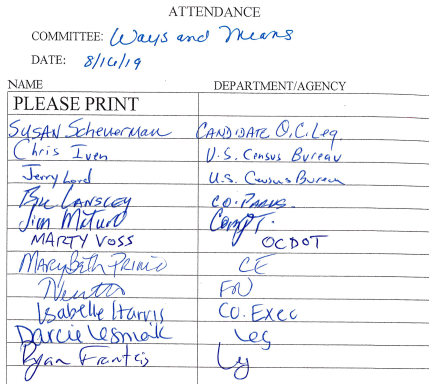
|










































